#so he accepted his pp on the album???
Text
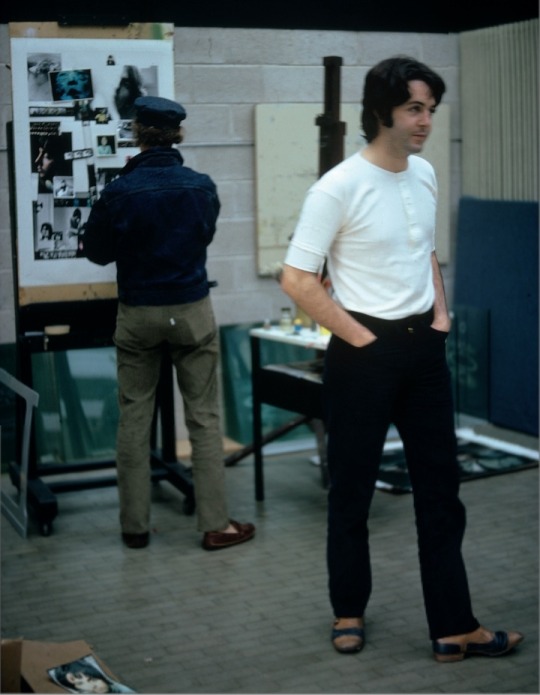


Paul McCartney assisting in the collage of photos for the album "White Album" and the official collage, 1968. ㅡ From the book "White Album: The Deluxe Edition".
#paul mccartney#the beatles#60s#1968#white album deluxe edition#so he accepted his pp on the album???#ok sir#we also accept that
232 notes
·
View notes
Note
I dont think I've ever heard the take that girl seems to be about Paul, I mean, it makes sense absolutely, but can you expand some more?
Gladly, Anon.
Rob Sheffield (Dreaming the Beatles) said he thinks Girl is about Paul in this episode of @anotherkindofmindpod. The episode is actually an in-depth discussion of In My Life, but Girl came up a number of times, since it's also on Rubber Soul.
I thought Sheffield's statement was interesting, and not in a silly “John saw Paul as a girl” kind of way.
Summarizing mercilessly, and taking a few steps back before returning to Girl:
RS argues that Rubber Soul marks a moment when the Beatles’ songwriting moved from a commercial/craft perspective towards a more open/confessional/personal tone, In My Life being an example of this, with John examining his feelings for all his friends and lovers, and singling out a new kind of love that transcends the loves he’s known before. According to RS and the hosts, In My Life is not only addressed to Paul (I personally feel it could also be about Julian, or about both; as someone who writes, I really feel the “a piece of art is never about just one thing” argument)— it also, by summoning a group of dear people and openly expressing his feelings for them, emulates Paul, who, in John’s eyes, is the more extrovert and socially comfortable of the two. The song is a two-fold tribute.
Girl, still according to RS, forms a matched pair with In My Life, because it, too, concerns complex and intimate emotions; in this case being unsettled by a complex, alluring and confusing person (Paul/the girl). It's a non-generic, specific, highly personal song you wouldn't have found on earlier albums. (You Won’t See Me is Paul’s reply to John.)
Whether you agree with these interpretations or not (by the way, instead of trusting my summary, it’s probably a better idea to listen to RS and the hosts in their own words), I’m happy to see the acknowledgment of the depth of John and Paul's relationship.
RS also makes a beautiful point about If I Fell (which, as we know, John saw as a continuation of In My Life): That John and Paul, as always, tell the truth about each other by the way they sing together.
(Cue the If I Fell/marriage vows quote from Gould’s Beatles bio).
Ian Leslie (no introduction needed) was more direct in his “Hidden Gems” episode on @onesweetdreampodcast. He stated he believes that If I Fell was written for Paul, commemorating their Paris ‘honeymoon’.
And look—people are free to go as far as they want in how they interpret all this, but I personally feel it liberates and elevates the discussion of their songwriting and relationships to include the romantic love or friendship or X or [redacted] or 'tender and tempestuous' but ‘not sexual as far as we know’ relationship between John and Paul as one of its many possible inspirations.
It just feels silly to me to ignore it or act all offended at the mere suggestion.
And when RS writes in Dreaming the Beatles “For John, Paul was the boy who came to stay; for Paul, John was the song he couldn’t make better,” it just feels right.
My two cents.
P.S. When I'm inclined to accept that Girl is about Paul, I immediately want to ask follow-up questions. Because this is a song about a fraught relationship, right? In what sense did John try to leave Paul? In what sense did Paul promise him the earth and cry? I know it doesn't have to be literally true, but some extrapolation, please? This didn't happen in the episode—obviously, since its focus was another song, In My Life.
PPS: I wrote this in a bit of a hurry so feel free to get back to me for clarifications, etc.
#rob sheffield#dreaming the beatles#girl#rubber soul#the beatles#john lennon#paul mccartney#if i fell#in my life#AKOM#mclennon#asks#one sweet dream podcast
98 notes
·
View notes
Text
YYH and Togashi's musical references
I always find new references every time I read the manga, so I’ll probably edit this post in the future with new ones. If anyone knows more refs, please leave a comment or a message and I’ll add in the post giving the credits.
1. International artists: most of the bands and artists are from the rock/metal scene.
Keiko reading UDO in her English Class (v.2, p.98)
UDO is a German heavy metal band founded by the lead vocalist Udo Dirkschneider (ex-Accept) in 1987.
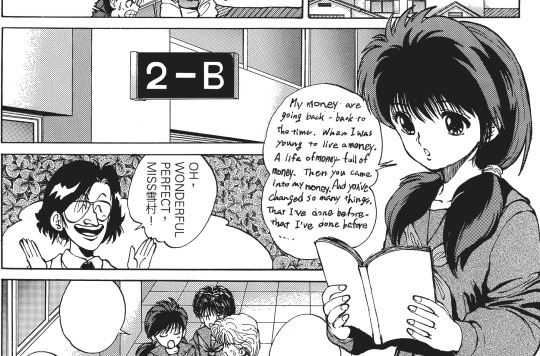
Keiko is reading an adapted version of the lyrics of “Unspoken Words”:
My thoughts are going back - back to the time
When I was young to live a life
A life of lies - full of lies
Then you came into my life
And you've changed so many things
That I've done before - that I've done before...
Togashi commented on the Table of Contents in 1991 that he was listening to UDO and Led Zeppelin as BGM. (WSJ issue 6, 1991)
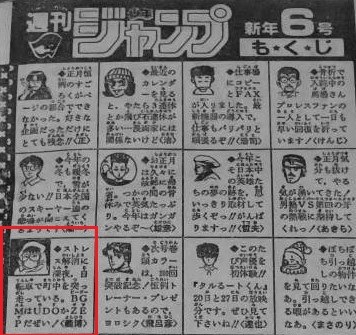
Kuwabara’s “Moter-head” T-shirt (v.3-4, Genkai’s Tournament)
A reference to “Motörhead”, English rock band formed in 1975 by bassist, singer, and songwriter Lemmy (RIP, 2015). We can also see the names of two famous Motörhead‘s albums on his shirt: “Bomber”, 3th studio album (1979), and “Iron Fist”, 5th studio album (1982).

“Sodom” is probably from the German metal band formed in 1981 and “Sabbat” is probably a reference to “Black Sabbath”, English rock band formed in 1968 whose vocalist Ozzy Osbourne is very famous.
Michael Jackson in The Dark Tournament (v.6, p.132)
A man who needs no introduction. Michael Jackson wearing his famous white gloves and 'Smooth Criminal' hat, bringing a thriller night into the Tournament ;-)
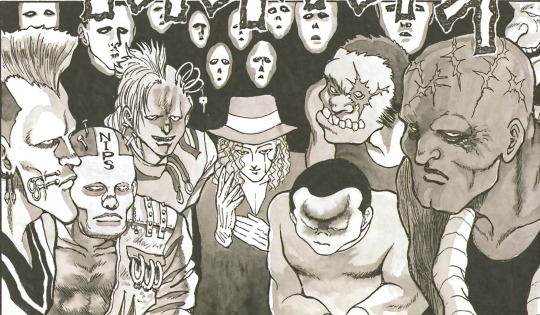
The Scalper of the Dark Tournament and AC ϟ DC (v.6, pp. 172-173)
The suit, necktie and newsboy cap have everything to do with Angus Young’s famous costume. He is the co-founder, lead guitarist and songwriter of AC/DC.

So, most of us believe that the ticket seller was modeled after him. “I’m on a Highway to Hell”!
Imajin from Team Rokuyukai and John Lennon (v.6, p.170)
The name “Imajin” is a reference to the song “Imagine”. His character’s design also had some inspiration from John Lennon, such as John's famous round glasses.

Chapter 62 Opening and The Clash (v.7, p.132)
The Clash were an English rock band formed in London in 1976. Yu Yu Hakusho 62nd Opening Act. "The Second Round Begins!!" was inspired by the cover of The Clash’s self-titled debut studio album (1977).

Paul Simonon (bass): Kuwabara;
Mick Jones (guitars): Yusuke;
In Joe Strummer’s place (RIP) there’s a suspicious couple in the background ⬇ XD
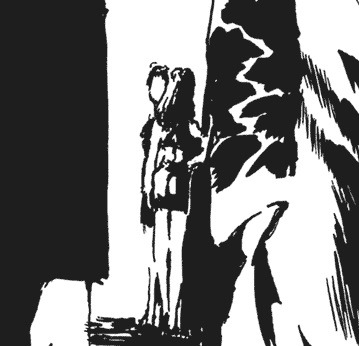
Kuwabara and Megallica (v.14, chapter 124. "Fierce Rain...!!)
This is a classic and everyone knows it, but it definitely deserves a mention. The day Kuwabara threw everything away to attend a Megallica’s concert.

A tribute to Metallica or both bands - Megadeth and Metallica - as Dave Mustaine's exit from Metallica and the founding of Megadeth in 1983 was a pivotal moment in the metal scene.
We can also spot a Metallica’s poster on the wall of Kuwabara’s bedroom in volume 6, chapter 46. "Springtime for Kuwabara!!" (p.14)

And another poster above the TV with the letters “ETH” written on it. Probably, a poster of “Megadeth”. It’s hard to tell, because the image is small, but it looks like the skeleton hand of Megadeth’s mascot Vic Rattlehead. (v.6, p.9)

2. Japanese artists: I included some actors as well, as most of them are also singers.
Daisuke Motomoto and Youki Kudoh (v.1, p.197)
Daisuke's type of woman is the famous actress and singer Youki Kudoh.
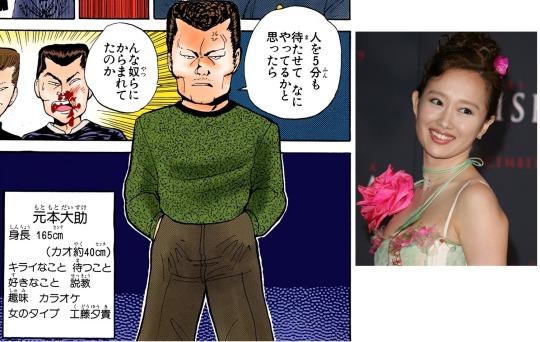
Shizuru: Bunta Sugawara & Ken Takakura (v.2, p.131)
Shizuru’s favorite type of man was two elder and renowned actors. Both were born in the '30s and appeared in almost 200 Japanese feature films.
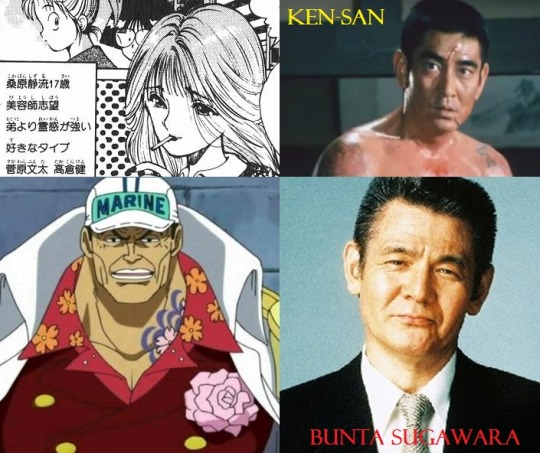
Born in 1931, Ken Takakura, known as Ken-san, was an actor and singer. He died of lymphoma on November 10, 2014. Born in 1933, Sugawara was also the model for the design of the One Piece character Sakazuki “Akainu.” He died from liver cancer on November 28, 2014 . Isn’t it a huge coincidence they both passed away of cancer on November 2014?
REBECCA [レベッカ] (v.1, p.192; v.3, p.163)
REBECCA are a Japanese rock band that had a great success in the 80′s, fronted by singer Nokko. Natsuko, Keiko’s friend, says a curiosity about REBECCA’s song “MOON”:
“It's true, there is a voice saying "SENPAI" at the beginning of the bridge” (note: bridge from the song structure).

It is said in the middle of this song, there is a mysterious woman voice calling "senpai" (veteran, senior). Honestly, I’m not sure if I can hear it lol.
There’s also a rumor that the three guys and girl who appear in volume 3 (upper left of page 163) during the lottery of Genkai’s Tournament are REBECCA. What do you think?
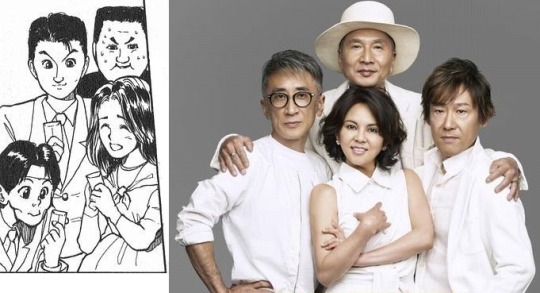
Eisaku Yoshida, actor and singer (v.4, p.46)
Kuwabara and Yusuke arrived in front of the Maze Castle in Makai in only 2 hours. Togashi made a joke about it and wrote a small text below the scene:
“Fast as the development of Eisaku Yoshida’s doramas.”
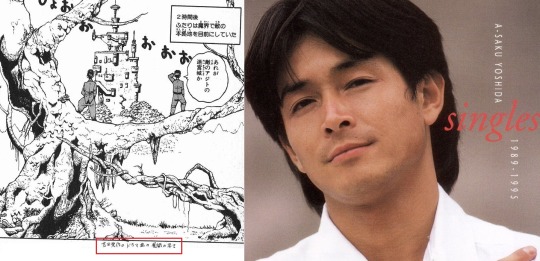
Akiko Matsumoto (v.6, p.152)
The actress and singer Akiko Matsumoto is a Japanese 80's idol. When Yusuke is sleeping in the ship, Kuwabara says Yusuke is so tired that he won’t get up even if Akiko Matsumoto was next to him.

Eriko Tamura in the Dark Tournament (v.6, p.158)
The super famous singer and actress Eriko Tamura appears in a panel during The Dark Tournament in the Hanging Neck Island’s Hotel. It was probably a reference to her manga/anime version of “Idol Densetsu Eriko” (1989).

Kuwabara’s Energy Drink and Pierre Taki (v.6, p.160)
The name of the front man for Japanese synth-pop group “Denki Groove” appears on Kuwabara’s energy drink. I’ve already made a detailed post about it and the polemic involving his name.
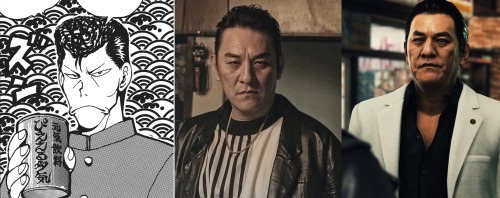
Space Battleship Yamato Opening Theme (v.13, p.62)
When the guys are about to leave the Hanging Neck Island, Yusuke starts to sing: “Saaaraaabaa” (Farewell) which is the beginning of the opening theme of the super famous anime “Space Battleship Yamato” (Uchuu Senkan Yamato, 1974), sung by Isao Sasaki.

Sensui, Itsuki and Jun Togawa’s performance on Hit Studio (v.16, p.17)
Sensui spares Itsuki’s life after he confessed he wanted to live one more day to watch the singer Jun Togawa on Hit Studio. Sensui also watches the show. In the anime, the line was changed to “the last episode of the dorama”.

Fun fact: Jun Togawa actually performed a few times on Hit Studio and Togashi said in an interview this was a moment he really experienced.
This performance is from 1984 and Togawa was promoting her debut album as a solo artist “Tamahime-sama”:
youtube
Trivia: to celebrate the 35th anniversary of Jun Togawa’s musical career in 2016, an album alongside the metal band Vampillia entitled "Watashi ga Nakou Hototogizu" ("I Will Sing Like a Cuckoo") was released. Togashi created black & white illustrations for their collaboration:
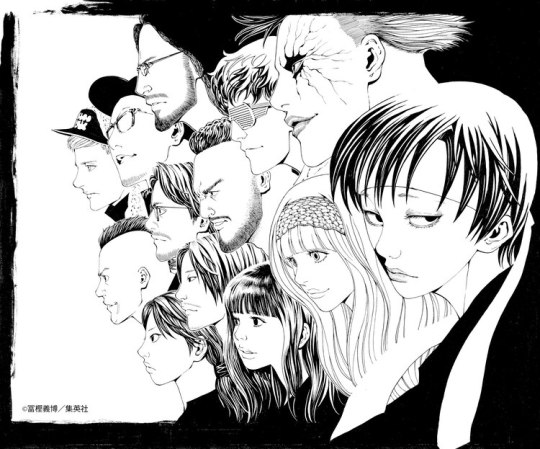
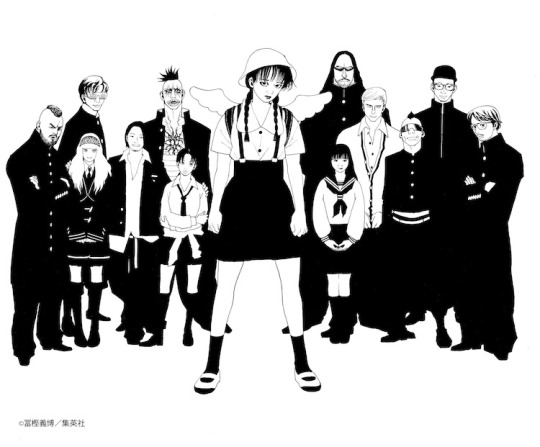
I know Togashi said in “Yoshirin de Pon!” (1994) that Mukuro was modeled after Kushana (Nausicaä of the Valley of the Wind) but Jun Togawa’s famous robotic arm from the 80′s reminds me Mukuro’s. She also performed the song “Radar Man” on Hit Studio wearing the cybernetic arm.
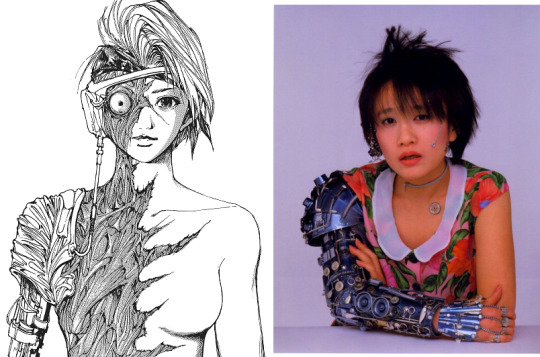
Akiko Wada and the earthquake (v.16, p.119)
When Sensui releases his sacred energy and the ground starts to tremble, a female citizen makes a comment: "Isn’t this Akiko Wada tapping her foot?". Akiko Wada is the famous singer, known as The Queen of the Japanese R&B. If you watch her performances, specially the from the 80s-90s, you’ll notice the peculiar way she shakes her legs and taps her foot while singing. When she debuted, she was also known for her tall stature, large physique and high tone voice.
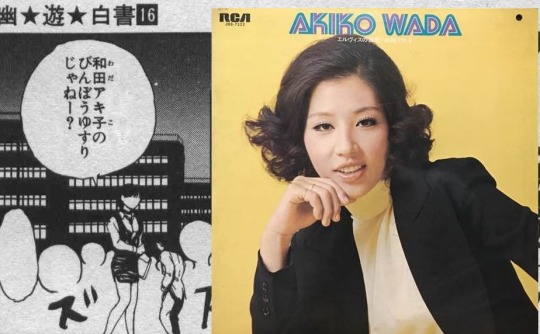
“Otoko Nara” (v.17. p.171)
After saying goodbye and being dumped by Keiko, Yusuke starts to sing the famous military and wartime song “Otoko Nara” (男なら - “If you are a man”) from 1937. Translation to English
Yusuke: “Otoko nara, larilarila....”

3. Other mentions and references
WSJ issue 25, 1992; v. 6 opening illustration and v.8 cover
According to Togashi’s comments from the Artbook, these guys next to Yusuke were inspired by two black guys Togashi saw on a music video or magazine. But as he doesn’t remember where the inspiration comes from, it’s hard to tell the origin.
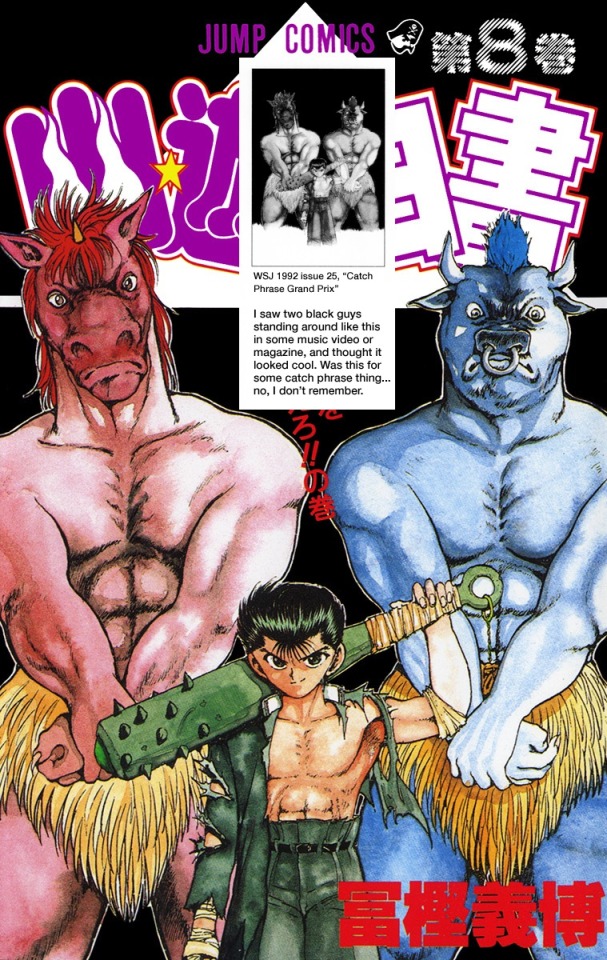
Anime: I’m only taking the manga and Togashi’s refs into consideration here. But you can always have fun searching in the animation for other references, like the Oingo Boingo poster in Kuwabara’s bedroom and Roger Dean’s artwork in the Makai landscape.
Other celebrities:
↪ Downtown (v.19, p.114-115): is a Japanese comedy duo consisting of Hitoshi Matsumoto and Masatoshi Hamada. Formed in 1982, they are one of the most influential comedy duos in Japan and famous for hosting variety shows, such as Downtown no Gaki no Tsukai ya Arahende!! Togashi has stated he’s a fan and even the name “Hunter × Hunter” came about while he was watching their TV show, in which the hosts often repeat what they say to make the audience laugh. People believe the TV program Juri, Koto and Ruka were attending in the last volume is a reference to the variety show. Juri calls one of the hosts Yamazaki-san which is probably a reference to Hosei Yamasaki one of the five members of Downtown Gaki no Tsukai's regular cast. The man watching the TV while smoking is Togashi.

↪ Kurama comparing himself to Kazaguruma no Yashichi from the dorama “Mito Komon” (v.5, p.201). I made a post about it.
↪ The family name “Minamino” was taken from the singer Youko Minamino, but other Japanese celebrities were also considered. I made a post about it.
↪ A mention to the late sumo wrestler Kurama Tatsuya (v.13, p.89). When one of Kurama’s senior overhear Kuwabara calling Minamino as Kurama, instead of using his human name, he says: Kurama? (using the kanji of the fighter’s name), the former sekitori?

↪ Byakko bringing up Carl Lewis (v.5, p.57) was hilarious. Kuwabara needed to jump a distance of 10 meters, 2 meters more than Carl Lewis. Probably a reference to the 1991 World Championships in Tokyo and Lewis' greatest achievements during the competition. These chapters from the Saint Beasts saga were being written during this time.

↪ Kuwabara’s name was inspired by two baseball players as Togashi explained in the comics and the databook. But he also mentions some achievements from other baseball players during the series and incorporates them in his sword techniques:
→ Hiromitsu Ochiai (v.4, p.74): The “Ochiai-ryuu Shui-dasha-ken” (The Leading Hitter Ochiai Style Sword) used by Kuwabara to bat Rando’s fireballs technique (Kashou Happa-ken) is a reference to the baseball player Hiromitsu Ochiai. He is considered one of the most important players in the history of Japanese baseball and was given the title of “shui-dasha” (leading hitter), a player who ends the season with the best batting average score. That’s why Kuwabara mentions “shui-dasha” in the name of the technique.

→ Satoshi Inamoto (v.5, p.55): During the fight with Byakko, Kuwabara wants to use his “Teikyo High School Sayonara Two-Run Homer Sword” to bat the Tiger Scream but he is stopped by Kurama.
There’s a small text written below the panel: “August 17, 1991, 12h45PM, hitter Inamoto”. It’s a reference to a match between Teikyo High School and Ikeda High School in 1991. Teikyo High School turned the game around and won thanks to Inamoto’s home run.

↪ Fubuki Sato and Masato Hagiwara (v.17, p.120): while her brother Kaisei likes to watch TV, Fubuki likes the actor, voice actor and professional mahjong player Hagiwara Masato-kun.

↪ Hiei and Medaka Ikeno (v.19, p.88): a woman on TV describes the ET (Hiei) who abducted her. “His height is about Medaka Ikeno”. He is a Japanese comedian known for his short stature, about 149cm, and for being the man whose 'size is same as a tie'.

↪ Arnold Schwarzenegger (v.19, p.113): when Kido goes to the movies, there’s a billboard announcing: “The Crying Game” (on the right) and “Schwarzenegger - Last Action Hero” (on the left). Toguro is said to be modeled after Schwarzenegger’s Terminator, but Togashi mentions in the Yu Yu Hakusho Artbook (2015) that "Younger Toguro is Sato", referring to Koji Sato, the main antagonist of 1989 film "Black Rain”, played by the Japanese actor Yuusaku Matsuda.

#yu yu hakusho#yoshihiro togashi#the clash#metallica#megadeth#acdc#angus young#motorhead#sodomband#black sabbath#udo dirkschneider#john lennon#michael jackson#carl lewis#jun togawa#rebecca#hiromitsu ochiai#kurama tatsuya#pierre taki#eriko tamura#roger dean#eisaku yoshida#bunta sugawara#ken takakura#isao sasaki#hit sudio#kazaguruma no yashichi#arnold schwarzenegger#last action hero#the crying game
203 notes
·
View notes
Text
"and the album of the year award goes to....BTS!"
the sound of the television echoed inside my living room as i sat on my couch watching an award show.
I have always dreamed to be a great singer and to be awarded in a prestigous award shows like that.
I loved singing, everytime i sang i can feel my emotions surge and the feeling of satisfaction everytime i express myself through singing. it used to be my passion.
Used to be- now everytime i sing all i feel is insecurity.
Years ago, I applied in a company called Bighit Entertainment it wasn't as big as other known company but i just feel that the company is perfect for me, that the moment i step there my life will change. So when I received the email that I was accepted for interview I felt estatic.
I immediately got up and told my parents about the news. And they were very happy and congratulated me.
I immediately got up and went to my best friend that lives next door.
"Kim Taehyung-ah! Taehyungieeee!"
I enthusiastically called him while jumping up and down outside of their door.
"Y/nie. you look very happy today." Taehyungs grandma said as she opened the door for me. I hugged he and said "Halmeoni i have a good news!" I said in very cheerful tone. "Oh, what is this news" you turned your head around and saw taehyung drying his hair. "What is it your being noisy about" he said.
You looked at him and noticed that he's so handsome als always. Of course you wouldn't say that to him, he will surely tease you.
"I got accepted for interview in Bighit Entertainment!" I said in a really excited tone. Except from your family Taehyung is the only person who knows how much you dreamed to become a known singer.
"Oh my, Congratulations y/n!" Taehyungs grandma said as she hugged me again. While Halmeoni was hugging me I saw Taehyungs face. He doesn't look very happy for me....
"Tae... Is there something wrong?... Are you not happy for me?" I said to him with a confused face. What's with his reaction? Halmeoni excused herself as she noticed the tension.
"Y/n, Of course I am happy for you! More than anyone, I am the one who knows how much you want this. It's just that Im worried that you'll get really nervous and mess up and beat up yourself afterwards. Don't you think maybe we should take small steps first? Maybe join a local singing contest first? or let's film you singing and post it online. Don't you think it's a bit too much for you?" taehyung said in a very careful tone. He is right, you know that.
"but its here tae, I don't want to waste the opportunity. We never know when will it happen again!" I reasoned.
Taehyung sighed as he took a step forward and went to hug me. " I am very proud of you, know that I will always be here for you..." I felt my cheeks heated as the distance closed between us.
I practiced very hard since then, I had a healthy diet to make sure that my voice will be in good condition for screening.
Then why?...
Why does my voice doesn't come out.
"Umm. anytime now". One of the staff instructed.
"A-ah y-yes!" I stumbled with my words as I felt my body shake from the nervousness.
The instrumental music started to play.
I have to calm down.. calm down pls. calm dow-I raised my head and saw the faces of the jury looking at me expectantly.
"S-he looks like a blue parrot.. wont you come fly to me~" I sang in a very shaky voice. Im going to fail.
"I want some g-good day..." I continued. Crap. I felt like crying and then i Looked once again and looked behind the judges..
Taehyungie.. He's there.
He mouthed "You can do it"
I slowly calm down and continued to sing."Imagine your face say hello to me and all the bad days they're nothing to me, with you~"
"Taehyung" I said as I ran unto taehyung slightly sobbing as your application got rejected. "I should've listen to you..*sob* "
" Hey stop crying, You know what's good when you fail? you can try again and do better next time!" He said as he flashed a very bright smile.
and just like that you felt the feeling of dread disappear.
"Excuse me" Someone suddenly tapped taehyung shoulder.
A Staff?
" umm yeah?"Taehyung reaponded to the person.
"Do you want to join the audition?" the staff asked
"Umm im just here to accompan-"
"Yes! He would like to! can he?.." You said cutting taehyung off.
He looked at you wearing a very confused face.
"Yes, follow me."
If there's one thing about Taehyung, He is very confident unlike you. I mean, if you looked like that, what's there to be ashamed about. Just like that, he became a member of the most wel known boy group of the generation.
"I would like to thank the armys for always supporting us. Borahae Army" Taehyung-now known as V said as he raised the very shiny golden thropy. It tells how much V has become and unfortunately, I am no longer a part of it.
**********************************************
Author's Note: I forgot how to turn the flashback into italic help-
Also it don't have a title because you never had label. This is inspired by that interview with Fallon.
PPS. I really intially used Obaachan and then I realized the most basic thing about taehyung-HE'S KOREAN. sorry my bad
#bts x you#bts angst#i like angst#author's a sadgirl#how to use italics in tumblr app#i use angst as an excuse to cry#i just finished my biochem exam i failed lol#give me some angst reccomendation pls
6 notes
·
View notes
Video
youtube
In this entry, I will explore the following critical question: in what ways does this video depict social truths in the United States?
Posted here is the music video from the fourth single off of Taylor Swift’s seventh album, Lover, titled “The Man.” Taylor Swift has been called into question throughout her almost fourteen years of fame about the boyfriends and break ups she’s had, and she has also been questioned about whether or not she deserves her fame. Swift wrote the song “The Man” to say that men in our society are not questioned or called out in the same manner. The music video that goes along with this song follows the character “the man,” who is played by Swift herself in makeup to look like a man. Overall, the song and the music video together show how there is a double standard for men and women in our society based on the societal gender norms that are followed in the United States.
Swift’s music video for “The Man” provides a narrative view of double standards based on gender in the United States. A narrative is the representation of at least two real or fictitious events or situations in a time sequence, neither of which presupposes the other (Palczewski, Ice, and Fritch, 2012). The music video begins with “the man” walking into his office for work and follows him through an average day in which “the man” is being completely obnoxious but is unopposed by everyone around him. The plot of the music video combined with the lyrics of the song challenge the gender norms of society by making you think about what would happen if a woman acted the same a man is allowed to act and by showing the unfair consequences of what happens when a woman does act the same way a man is allowed to act.
One way this narrative is depicted is when “the man” is characterized as a disinterested father on his phone in the park with his daughter. “The man” hangs up his phone and picks up his daughter, and people immediately gather around him while cheering and clapping for him. A banner then shows up in the background that says. “World’s Greatest Dad.” All of this happens while Swift sings, “If I was a man, then I’d be the man.” This shows a double standard in which men are praised for being viewed as involved parents. Since “the man” is being perceived as an active father for taking his daughter to the park and picking her up, he is The Man. For women, however, being an active parent is something that is expected of them, and they do not receive praise for being involved parents. Likewise, when a man is not actively involved in his child’s life, people tend to not say anything, but if a woman is not actively involved in her child’s life, she is looked down on by society.
This narrative is also depicted when Swift sings, “I’m so sick of them coming at me again…” while “the man” plays in a tennis match, and the umpire makes a call that is not in “the man’s” favor. “The man” fills with rage as he begins yelling about the call, and he then throws a tennis ball at the umpire. This is a reference to Serena Williams at the 2018 U.S. Open in which Williams yelled at an umpire after a series of unfair calls (USA Today, 2018). The double standard here is in reference to the difference in how people act when situations like this occur. Williams was given a penalty in the match in which she yelled at the umpire and was looked down on by society after this incident and was unable to live it down for months after. She was framed negatively by the media all over the country, and many news articles about the event were written about “Serena’s temper tantrum.” However, “the man” is not given any consequence by the umpire in the music video. This is because yelling and being aggressive, to an extent even physically aggressive, when things do not go your way are acceptable for men in the United States society but not for women.
A third way Swift depicts this narrative is at the very end of the music video when “the man” walks over to Swift, who is sitting in a directors chair and says, “Hey, just checking, was that last take more what you had in mind?” To which Swift responds, “Pretty good. Uh, could you try to be sexier? Maybe more likeable this time?” Here Swift is using role reversal in her narrative to show the double standard between men and women in the United States. Women in the United States society are not always judged for how capable they are of doing their job like men are, but they are judged on how attractive they are or how well-liked they are. This is also in reference to comments along the same line that Swift herself has received from directors.
Johh Rodden writes in his essay “How Do Stories Convince Us? Notes Towards A Rhetoric of Narrative” about different ways to analyze narratives, and how narratives can be used. He says, “A rhetoric of narrative does still include a substantial rational component, but its concepts are less dry or mechanical or head-centered, and instead more full-bodied and even impassioned. They are rational but also emotive and ethical.” This can be applied to Taylor Swift’s “The Man” music video because the video shows characters with strong emotions that are intended to grab the audience’s attention and help them understand a rational point made by the song and the music video. This can be seen in the second verse of Swift’s song when she sings, “They would toast to me, oh, let the players play. I’d be just like Leo, in Saint-Tropez,” while “the man” is on a yacht full of models obnoxiously yelling at his butler and drinking and champagne. Here Swift is taking an impassioned attempt to show the double standards between men and women in United States society by comparing herself to Leonardo DiCaprio, also known as Leo. DiCaprio is notorious for staying on his yacht with countless supermodels, and no one says anything about it, unless it’s a “Wow, good for him.” However Taylor Swift is under constant scrutiny for having what the public has deemed as “too many relationships.”
Overall, the narrative of “the man” in Taylor Swift’s music video for “The Man” tells a story that helps the audience gain an understanding of the point Swift is trying to make. Swift is making it clear that there is a double standard for men and women in society. Men are allowed to basically do what they please and get away with it. Women, however, are looked down upon, and frequently face social consequences, in United States society when they act in the same ways men are allowed to act.
WORKS CITED
Chase, Chris. ���Serena Williams Has Another U.S. Open Meltdown, Clashing with Umpire in Shock Loss.” USA Today, 11 Sept. 2018, ftw.usatoday.com/2018/09/serena-williams-has-another-u-s-open-meltdown-clashes-with-chair-umpire.
Palczewski, C. H., Ice, R., Fritch, J. (2012). Narratives. In Rhetoric in civic life (pp. 117-146). State College, PA: Strata Publishing, Inc
Rodden, Johh. “How Do Stories Convince Us? Notes Towards a Rhetoric of Narrative.” College Literature, vol. 35, no. 1, Winter 2008, pp. 148–173. EBSCOhost, doi:10.1353/lit.2008.0007.
Swift, Taylor. “The Man.” YouTube, uploaded by Taylor Swift, 27 February 2020, https://www.youtube.com/watch?v=AqAJLh9wuZ0
1 note
·
View note
Text
Post-Bitches Brew Resistance

Miles Davis did not receive universal applause for his crossover into the Boomer world of self-exploration. Some saw his new ideas as a maneuver to erase the debt that had accumulated over the past years exploring inaccessible abstract sounds while living an extravagant life of cavorting with celebrities, traveling overseas, and maintaining a lifestyle of excessive self-indulgence.

Critic Stanley Crouch is one who associated Miles’ post-1968 with Zip Coon-nineteenth century minstrelsy. The attire that Davis acquired and the embrace of calculated gestures to Crouch, similar to the invective leveled at Bob Dylan at the 1965 Newport Folk Festival, was a betrayal to his previous association with authentic revolutionaries whose mission was to elevate the race and reject the “Uncle Tom”, “Armstrong-like mugging and grinning” for mass approval. In his 2007 publication, Considering Genius, Crouch eloquently composes these thoughts:
“Gone is the elegant and exigent Afro-American authenticity of the likes of Ellington, at ease in the alleys as well as in the palace, replaced by youth culture vulgarity that vandalizes the sweep and substance of Afro-American life. The fall of Davis reflects perhaps the essential failure of contemporary Negro culture: its mock-democratic idea that the elite, too, should like it down in the gutter. Aristocracies of culture, however, come not from the acceptance of limitations, but from the struggle with them, as a group or an individual, from within or without.” (Crouch, p. 256).
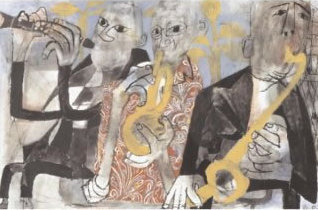
Despite accusations leveled by Crouch and other traditionalists that this music was not true Jazz, what Miles created in August of 1969 immediately resonated as it was representative of the zeitgeist that permeated culture and continues to influence our perception of life in 2019. Multiculturalism, globalism, and synthetic materialism are prominent characteristics of Postmodernism. We challenge language, symbols, credentials, and motivations of those whose authority threatens our personal identity. The need to establish individuality by definition fragments us from the whole, and our own individual whims mandate how the pieces are reassembled or not. Technology reinforces this by allowing our own imagination to define our image, and tribalism influences our choices affecting our instincts for survival. Some describe Miles as selling out, others marvel at his obsession to maintain relevance. Perhaps apropos to our postmodern perception we see what we wish to see, and his true gift was to exist on both sides of the divide. Miles as griot told the story of that moment in time by engaging younger artists and masterfully directing them with his seasoned voice. Judging by audience ovation witnessing his new direction, he converted many.

The cover that adorns his controversial 1969 project is the depiction of Black Power and Afro-centricity. The surreal art was created by Mati Klarwein, an artist who was born to two Jewish parents in pre-war Germany who fled to Palestine with the two-year old Mati to raise him in the ethnically diverse environment of Palestine.
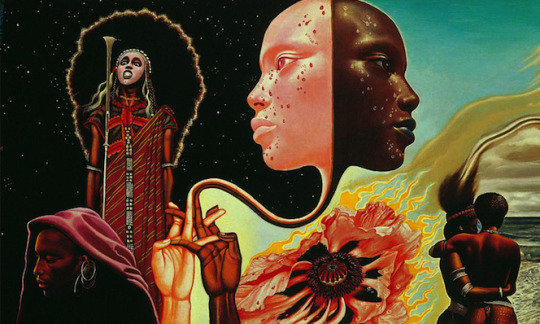
The binary imagery: light and dark, black and white women interlocking heads and fingers, anger and peace, intimacy and loneliness, strength and weakness, bring together opposites and communicate coexistence. Miles’ choice of Klarwein’s art also reflects his own inclinations in support of icons of Black Power, Blaxploitation, and Pan-Africanism.

His reaction to the 1968 murder of Dr. King in Miles, The Autobiography reads:
“Just before we left to do these concerts [in Berkeley, California], Martin Luther King, Jr., was killed in Memphis, in early April. The country erupted into violence again. King had won the Nobel Prize for peace and was a great leader and a beautiful guy, but I just never could go for his non-violent, turn-the-other-cheek philosophy. Still, for him to get killed like that, so violently—just like Gandhi—was a goddamn shame.
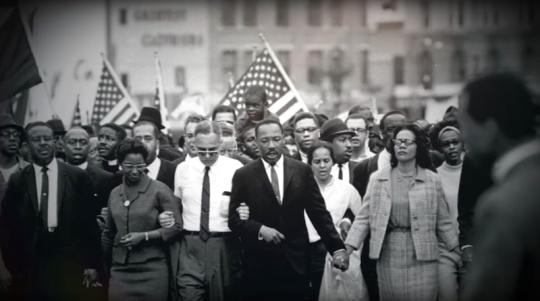
He was like America’s saint, and white people had killed him anyway because they were afraid when he changed his message from just talking to blacks to talking about the Vietnam War and labor and everything. When he died he was talking to everyone, and the powers that be didn’t like that. If he had just kept talking only to blacks he would have been all right, but he did the same thing that Malcolm (X) did after he came back from Mecca and that’s why he was killed, too, I’m certain of it.”(Davis, pp. 289-290)

Having passed fearlessly into the new world of electricity, Miles continued to move forward leaving those critical of every new experiment in his wake. He followed Bitches Brew with A Tribute To Jack Johnson, the soundtrack to the 1971 documentary on the flamboyant African-American world heavyweight boxing champion from 1908-1915 and predominant Jim Crow era icon. Miles was obsessed with boxing and idolized champions such as Johnson, Joe Lewis, and Sugar Ray Robinson for their audacity and charisma. His enthusiasm for the sport compelled him to hire a trainer, and experience it as a participant.
youtube
His music betrays the intimate knowledge of this craft in his jab-like fragmented gestures, affinity for shuffle grooves like the dancing motion around the boxing ring, and keen sense of timing required to deliver his strikes with overwhelming results.

The Jack Johnson soundtrack was then followed in 1972 with On The Corner, an album whose sound and album cover go deeper into the James Brown/Sly Stone inspired psychedelic funk and Blaxploitation trend, further confounding those waiting for a nostalgic return to the 1950s. Even as these projects were released, his health and lifestyle excess were beginning to take a toll on his productivity and creative energy, and he began to withdraw into a period of retirement from music and public life altogether.
youtube
2 notes
·
View notes
Text
Constellation No. 35
There is a third consideration we have to deal with in connection with the general character of lyric poetry. It is the nature of the general stage of human development and culture from which the isolated poem originates.
In this respect, too, the Lyric occupies a position which is to be contrasted with Epic poetry. In other words, while we regarded as necessary for the full bloom of the true Epos a phase in the nation's growth which was, speaking generally, undeveloped, at least in the sense that it had not ripened in the prosaic acceptance of its actual life, the times which favour most of all lyrical composition are those which already are in possession of a more or less fixed organization of social condition. It is in such a period that the individual seeks a reflection of his intimate personal life in contrast to this outer world, creating from it and within its limits an independent whole of emotion and idea. For in the Lyric it is not, we repeat, the objective solidarity and individual action, but the individual person as self-conscious life which supplies both content and form. This, however, must not be understood in such a way as though the individual, in order to express himself in lyrical form, must perforce disjoin himself from every connection with national interests and the opinions, and with rigid and exclusive severity remain as he stands.
On the contrary, with such an abstract self-subsistency we should only have left us for content the wholly contingent and particular passion, the mere caprice of concupiscence and affection, false idiosyncrasies and distorted originality would have unlimited opportunities. Genuine lyrical poetry, like all other poetry, has no doubt to express the content of the human heart in its truth. Yet none the less, regarded as the content of the Lyric, what is most a matter of fact and substantial must appear absorbed in personal feeling, vision, imagination, and thought. And, in the second place, the question here is not so much simply expression of the personal inner life, is not so much concerned with a primary and direct statement in the epic fashion, what the facts are, as with an expression of the poetical nature in a manner both artistically fruitful and wholly different from chance and ordinary modes. It follows that the Lyric requires, precisely on account of the fact that the concentrated life of the heart unfolds itself in manifold feelings and comprehensive views, and the individual is conscious of the poetry of his most intimate life as nested in a world that is already more prosaically organized—an artistic culture already secured, which must assert itself as the flower and independent product of the individual's natural endowment thus trained to a perfect result. For these reasons the Lyric is not limited to particular epochs of the spiritual development of a people, but is the rich blossom of the most varied. To an exceptional degree is it favoured in more recent times, in which everybody is entitled to have and express his own views and emotions.
G.W.F. Hegel, Vorlesungen über die Ästhetik [The Philosophy of Fine Art] (1820-1829), translated by F.P.B. Osmaston (London: G. Bell and Sons, 1920), Vol. IV, pp. 206-207.
What rock does preach, and what its detractors refer to as narcissism, is more properly called solipsism. Rock asserts that everything the senses apprehend is properly part of self, and the object of selfhood is to reach full growth, when self becomes synonymous with the universe. This solipsism is the opposite of Freud's or [Christopher] Lasch's narcissism. Narcissus at poolside is locked forever in annihilating self-admiration-"bang bang." The rocker's cry, on the other hand, is the solipsistic motto, "You Gotta Move." Solipsism is the invariable mental disposition of the vulgar pantheist, because in solipsism there is no transcendent anything, only infinite me.
Solipsism has always annoyed philosophers because it is irrefutable. Each time you produce evidence of an objective reality exterior to me, I reply that the evidence only exists as my own sensation. The universe is only what I feel. The philosophers have objected that if solipsism were true, then language itself would be meaningless, because language assumes objective, durable relationships transcending the mere selfhood of any one speaker, whereas solipsism implies that all language is just another way of saying "me me me," or as Whitman has it, language is just another symbol in the "universal hieroglyphic" each of whose symbols translates as "I." If every statement is just another expression of one thing-that is, myself-then language for the solipsist is infinite but pointless because it has no objective validity. But, the philosopher points out, even as it makes this contention, solipsism assumes the objective validity of language, for otherwise solipsism's own argument would be meaningless, and therefore solipsism refutes itself.
Solipsism's reply to this is obvious, and the rocker makes it:
Sha dada da / Sha da da da da / Yip yip yip yip/Yip yip yip yip / Mum mum mum mum /Mum mum mum mum.
The Silhouettes' 1958 hit "Get a Job" is the classic example of rock's love of nonsense syllables. The vulgar rocker takes his solipsism to its limit and rejoices in the conclusion that language is meaningless. He doesn't care if his words make objective sense and in fact is pleased when they don't. Words, say the Police in the song where they explicate the Silhouettes' lyric, "De Do Do Do, De DaDa Da"-words are
only chits I've left unsigned / From the banks of chaos in my mind.
The primal chaos of the brain is infinite, but as soon as this chaos is reduced to verbal order, it loses its wholeness and becomes a tool for tyrants:
Poets, priests, and politicians / Have words to thank for their positions-- / Words that scream for your submission.
The tyrants of language use words to create refined, transcendent laws which they impose on the wholesome chaos of the mind:
When their eloquence escapes you, / Their logic ties you up and rapes you.
Rock in its vulgarity wants no part of eloquence or logic, both of which are devices used by transcendence to limit the pantheist's infinite universe. In "Eskimo Blue Day" the Jefferson Airplane make the same point:
Redwoods talk to me, / Say it plainly, the human name / Doesn't mean shit to a tree.
Names themselves are meaningless impositions on the wholeness of nature and to be rid of them, the Airplane says, is "animal gain for me.” Mark E. Smith of the Fall, whose lyrics dispense with the logic of ordinary speech, calls one of their albums Perverted by Language.
"Do de de de, do da da da," say the Police. Because they are incapable of making any transcendent sense, nonsense syllables are the most honest form of language. They cannot be pressed into the service of logical systems, religious hierarchies, or totalitarian platforms. All they can do is express the wholesome feeling that is the "chaos of my mind":
Their innocence may pull me through / They're meaningless, all that's true.
That is, because they're meaningless, nonsense syllables stand for all that can be said with truth. Rock's critics often condemn it for being inarticulate. Rock itself esteems inarticulation as a virtue. The rocker acts on Wittgenstein’s observation that what the solipsist means is quite correct; only it cannot be said, but makes itself manifest."
Critics like Lasch blame narcissism for what they perceive to be the cultural poverty of modern culture. According to Lasch, the narcissist, "lacking any real intellectual engagement with the world," has little capacity to appreciate the blessings of culture. What this charge amounts to is the objection that popular culture in its vulgar solipsism has no time for the transcendent logic by which refined culture used to sustain itself. Pop culture denies any transcendent values outside of self by which we can make sense of the universe, and this denial is the essence of vulgarity and the not-too-latent reason why critics of the old order are anxious to label solipsism as narcissistic neurosis and ship it off to Bedlam.
In rock, the solipsism of the Romantic German philosopher Fichte acquires vulgar life, and the world has as much or as little to fear from rock as it would from the adoption of the morality outlined in The Science of Knowledge. In that book, Fichte asserted a completely subjective pantheism in which the self alone constitutes the universe, and yet Fichte stresses the moral propriety of his self-centered universe. Whitman's critics accuse him of advocating a pantheism of moral disorder but Whitman in word and deed is a model of kindness, decency, and toleration. There is no reason to think that rock's vulgar solipsism lacks the moral rectitude of its Romantic predecessors, and every reason to suspect that the charges of immorality made against it arise from the threat rock poses to the systems of transcendent objectivity espoused by its accusers.
Robert Pattison, The Triumph of Vulgarity: Rock Music in the Mirror of Romanticism (New York: Oxford University Press, 1987), pp. 180-183.
#G.W.F. Hegel#Robert Pattison#The Triumph of Vulgarity#Solipsism#The Philosophy of Fine Art#History of Subjectivity#Rock Music#J.G. Fichte#Romanticism#Idealism#Walt Whitman#Mark E. Smith#Ludwig Wittgenstein
9 notes
·
View notes
Text
I Hate the Cross of Christ
Author's Note: This is a confession. I write these words as I struggle with the sin tangled deep in my DNA. As a Christian, I know the beauty and value of the cross and I am not denouncing it. But, as you will see, the cross messes me up. Big time. I write to help bring clarity to my own struggles, but also to attempt to give words to those who can't explain their own unsettling experience with the cross.
When I survey the cross
Ah, the glorious, bloody, disgusting, offensive cross. My least favorite part about being a Christian. I have no shame in saying this. The cross and all its symbolism are offensive to me. They repulse me. I hate it.
The scene of the cross is everything my "holiness" upbringing screamed against. Excessive violence, mockery, alcohol, nudity, and murder all have cameos in the triumphant story of Jesus. It offends me. Let me explain how:
The cross of Jesus offends my senses as a human being. I don't wish death on anyone, but especially not this type of death. I would be perfectly fine with a world that has no violence, yet God himself suffered violence at the hands of his own creation. Which brings me to my next point...
The cross of Jesus offends my intellect. It is said that the cross of Jesus is what freaked out Fredriech Nietzsche because he just couldn't understand how the all-powerful God could allow himself to be tortured like this. This eroded Nietzsche's sense of logic and he then turned away from religion. I see his point. It is hard to sync the logic of this world and the foolishness of the cross. If I daily pursue more personal power and popularity, then why should I worship someone who freely gave it all up? The cross doesn't make sense. Speaking of popularity...
The cross of Jesus offends my cool. It ain't cool associating yourself with the ideals of the cross. The phrase, "Hey let me tell you about a bloody naked dude who was tortured and killed" never gets you many friends. Going to church, denying yourself, and following the path of Jesus in the way that he directs us to is not the path to popularity. I like being popular and loved. I seek it. Call it an acceptance deficiency that comes baked-in to adopted kids. I want to be like the cool kids. With my ego, I want the cool kids to be like me. The cross doesn't fit into that worldview.
And let's be real for just one second, Christian culture has tried to make the cross as cool as possible by skirting the realness of the situation. A focus on the cool benefits of Jesus death demands a focus on what's best for us. Co-opting the cross for personal gain is the goal of many Christians (this, I confess, includes me). The best metaphor for how we carry our cross is the diamond-encrusted Jesus piece that hangs from our necks. When you turn a symbol of suffering into a symbol of success you've missed the point. About missing the point...
The cross of Jesus offends my ambitions. The point of Christianity is to live as Christ lived. How did Jesus live? I borrow from Brett McCracken's take on Phillippians 2:5-11:
"Every taking-up-our-cross loss that we endure is worth it. For Christ and for us in him, weakness, suffering, and loss are not the end of the story. They lead to victory, resurrection, and eternal gain. The beautiful hymn of Philippians 2: 5– 11 captures it well. The first half is a descent: Christ leaves his heavenly home, forgoing his “equality with God,” emptying himself and reducing himself to the form of a servant by becoming human. Then further down: he is obedient to the point of death. And further down still: “even death on a cross” (v. 8). At this lowest point the passage pivots to ascent: God exalts Christ and gives him the name above all names. Then further up: every knee worships him in heaven and earth. Further up still: “every tongue confess[ es] that Jesus Christ is Lord, to the glory of God the Father” (v. 11). This is the trajectory of the Christian life. Like Christ, we descend to ascend. We humble ourselves, shunning our status, accepting the depths of our depravity. And then we are exalted with Christ. After suffering, glory. After the cross, resurrection. Every loss is worth the gain of Christ. " -- McCracken, Brett. Uncomfortable: The Awkward and Essential Challenge of Christian Community (pp. 55-56). Crossway. Kindle Edition.
I am supposed to live a descending life. One that gives up control to the one who gave up control. To sacrifice comfort to the one who sacrificed ultimate poshness. I am supposed to love even when it hurts because of the one who hurt because he loved.
And my ambitions are instantly crushed.
When I first started with this website and church-planting project I secretly had some ambition to prove that I could do it—that I am smart enough, capable enough, ambitious enough to build something.
The cross of Jesus is offending me out of this type of thinking.
And you know what. I am super-uncomfortable admitting that.
My Hate is Sin
I easily recognize my hate as sin. These feelings that I have toward the cross need to be nailed to the cross in surrender. The cool, the ambition, and the pride that suggests that I know a better way to live than God himself needs to be put to a glorious spiritual death.
Jesus submitted to the destiny of the cross just so I could also submit to my destiny of the cross. To be truly alive, we must first taste the death of our shackles and chains. And in the deep heart of the night, my ultimate yearning is to be alive.
So, do I hold on to this hate because it is the comfortable known? Or do I take the Via Dolorosa that Jesus has paved for me? Both are pain. Both are extremely uncomfortable. Only one is sin.
Together Empty Church is embracing the uncomfortable. Join us as we dig into Brett McCracken's new book Uncomfortable: The Awkward and Essential Challenge of Christian Community and uncover all the parts that make us uneasy about our faith, uneasy about being friends, and uneasy about building a church that realizes that comfort is not the goal of Christiantiy.
About the Author | Josh Schaidt
Twitter – Facebook – Instagram I love cookies and I still buy music one album at a time. @EmptyChurch is one way I live empty, talk faith, and opt in to follow Jesus.
Please remember our Rules For Discussion when commenting.
This American Church
A place for exploring the Church in the American context. Issues may get political, cultural, and philosophical — but it’s always personal.
→ Read more about This American Church here.
4 notes
·
View notes
Photo

(feature image by Shayan Asgharnia)
I first came in contact with Los Angeles based superhero Sama'an Ashrawi a few months back. I was at my 9-5 when he hit me up via email to talk about the Afrofuturistic web series that he was co-producing for DUST. He had found a piece I’d done on Missy Elliott’s love for spacey visuals and we soon started chatting about media, art, and futuristic Black life.
I figured out pretty quickly that Ashrawi was way more dope than I could’ve ever imagined. He’s met Herbie Hancock, Ladybug Mecca, Thundercat, and countless other legendary creative pillars. Since we’ve been in touch, he’s shared great stories about his life with me and I’m grateful that someone with his experience is that open. I mentioned that I wanted to interview him and he quickly and graciously accepted. So, without further ado, here is my chat with Sama'an Ashrawi, Trill Gladiator.
⭐️
Who are you?
My name is Sama’an, my friends often refer to me as “dad” because:
a) I like to make sure everyone stays hydrated when we go out dancing
b) my dance moves are pretty stiff (almost nailed a Milly Rock last weekend, but I’m not quite there yet), and
c) because I am very much into puns.
I also get called “William Miller” a lot because my hair and career have a lot of similarities to the kid from the movie Almost Famous. This clip = me. From a young age, I’ve been able to gain the trust of, and land interviews with, really big names. I was 20 when I interviewed Raekwon for the first time, 21 when I interviewed Kendrick Lamar and Damian Marley.
What sparked your interest in Afrofuturism?
The short answer is: a combination of things in my upbringing.
The long answer is:
Since I was a teenager, I was into the music of Hendrix and George Clinton and watched plenty of Star Trek thanks to my parents; they met in college as political activists and over the years have introduced me to their many friends who were veterans of various liberation movements. My parents and their friends taught me intersectionality before I was introduced to that term in college.
Though I can’t be sure if it happened on Twitter or in the classroom, I discovered the music of Sun Ra and Fela Kuti and the idea of Afrofuturism as I pursued a minor in African Diaspora Studies. The Af Am classes I took were hugely important in shaping my understanding of the uniqueness of the psychology of the African American experience, but I think it was my parents’ homegrown education that gave me the foundation to be aware of and open to those ideas.
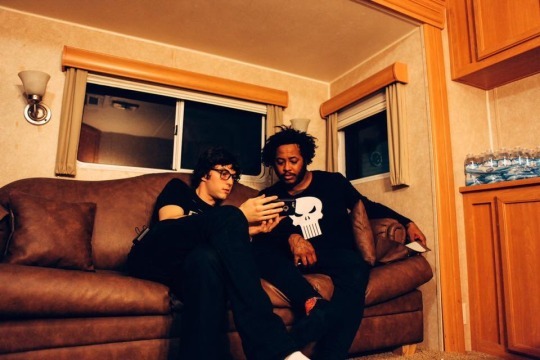
(shot by Sarah Jasmine Montgomery)
College changed my life. It’s where I paid my dues. It’s where I met so many of the people who would open doors for me and help me set my sails. Many of them I still work with to this day. But I think the two most important things I did in college were: becoming a producer at, and eventually entertainment director of, Texas Student TV (our student-run TV station) & minoring in Africa & African Diaspora Studies.
I think when people try to downplay the history of racism in this country, pointing them to Sun Ra is a great rebuttal because it’s like… things were really so bad that Sun Ra wanted to take black people to a whole new planet. That Sun Ra’s escapism was so heavy and yet he could still present it in such a beautiful amd melodic way still blows my mind. In general, I think art that comes from marginalized communities has the ability to cut through the static in a way that is unparalleled— more than a speech ever could.
Have you learned anything in the last week?
Hmmmm what have I learned in the last week? I learn so much from my friends every day, you’re making me want to start a journal dedicated to the things my friends teach me. Some wisdom that my big brother Gary Clark Jr just imparted to me is: when you’re collaborating with someone, it’s like a dance; if you’re moving at two different speeds, you’re gonna trip each other up. So if you feel like you’re moving faster than the other person, pump your brakes.

(shot by Marco Torres)
How did you meet Bun B?
I just had the treat of witnessing him tell this story last time I was in Houston. It’s way more cinematic when he tells it, but, we met almost exactly 7 years ago, in July of 2010. It was the summer after my sophomore year at The University of Texas and I had just been handed the reins to produce the hip-hop show at our school’s student-run TV station, Texas Student TV. The show had formerly been called ATX Most Wanted, but our entertainment director at the time, the now Emmy-winning Tabitha Lipkin, said she wanted me to come up with a new name.
I had driven to Houston from Austin to cover Trae Day— underground legend Trae Tha Truth’s city holiday and its corresponding concert. (PS Trae gave me a lot of my first looks, and for that I am forever grateful—later, when I became entertainment director at the TV station, I would get his videos and cartoon sketches played on the station. PPS I may or may not have a cameo in this music video, I’ll let you find it though)
At any rate, Lupe Fiasco happened to be at Trae’s concert and so I went right up to him and introduced myself; my sister was with me and she got a great, sweaty picture of us together that I need to dig up. (As the years have gone by, Lupe has been a sort of enigmatic mentor figure, appearing a few times a year to give me encouragement or advice, and whenever I’ve needed to do an interview, he’s always said yes.)
Anyway, at Trae Day I also met a rapper named Troublesum; she and I struck up a conversation and she asked, “Are you going to Bun B’s album listening session tonight?”
I was like, “I had no idea that was even a thing.”
So she gave me the deets and a few hours later we met back up there. This was Bun’sTrill O.G. album which has the distinction of being the last album given 5 mics by The Source. Troublesum introduced me to one of Bun’s managers, Bone, I gave him my spiel and asked if I could interview Bun. He said, “Once we’re done listening to the album, I got you.”
You’ve gotta know that growing up in Texas, Bun is looked at as a Greek God, mythical and omnipotent. I thought it would take me years to meet the man, let alone interview him. Here I was, just a few months into my “career”, and I was in a studio sitting next to Lupe Fiasco and Young Buck (lol) waiting to interview Bun.
The new name for the show I had come up with was simple and to the point, “Longhorn Hip Hop”; Our school mascot is the Longhorns, so it made sense. I told myself, okay, if it sounds good coming out of Bun’s mouth, it’s gonna stick (Bun would tell me I should say “pause” here, but this isn’t his interview so I’m not gonna say it!) So we did the interview, it went well, and Bun said something like, “Shoutout to Longhorn Hip Hop; Hook ‘em Horns, baby,” and I was like, “Yup, that’s it.”
Then I ended up at a lot of events over the next few months that Bun also was at and built up a good rapport with the people around him; I think understandably Bun is wary of letting new people into his circle, so he kept his distance from me at first to see if I was a genuine person. But the way Bun likes to tell it is that the breakthrough moment was when I showed up to his bodyguard Truck’s birthday party the next year, that was what made him initiate me into the Trill Gladiators. When Bun tells the story he always emphasizes the fact that, “Sama’an came allll the way to the HOOD” haha but for me it was more about supporting the people who supported me. And to this day, Bone, Truck, and Bun, among others, have always been there for me.
Do you feel lit? You’re pretty poppin in my opinion, but how do you feel about yourself?
Haha you know, I’m not sure I’ve ever used the term “lit” un-ironically mainly because I’m not sure it’s for me to say. I think I’ve done a lot of cool stuff, can’t deny that, but I’ve still got a lot of growing to do. One person who inspires me a great deal is Hannibal Buress; I look at how long he grinded it out before he caught his big breaks and it motivates me to keep going.
How do I feel about myself? Truthfully, maybe this says a lot about me, but I never take selfies. Is that weird? Like if you follow me on snapchat, you’ll rarely if ever see me post selfie pics/videos. What does that say about me? Idk.
What’s the most important part of your creative process?
Movement. Going for a walk, or a drive to a far away place, or playing basketball. Something about taking in new surroundings helps me get my ideas out, especially if I’ve got writer’s block.
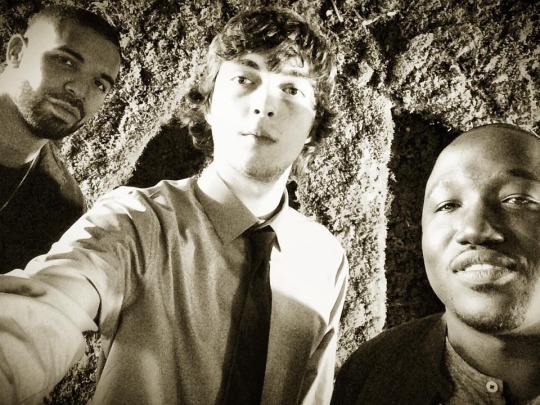
Write three sentences. One for the past you, one for the current you, and one for super duper grown up you.
Past – Maybe don’t tweet so much.
Present – Sometimes growth is stressful and crying is okay.
Super Duper Grown Up – Please tell me I grow up to be a late night talk show host.
That’s all folks! Thanks for reading~
-Brooklyn White
#Sama'an Ashrawi#trill gladiator#creative#music#culture#brooklyn white#interview#afrofuturism#thundercat#bun b#UGK#herbie hancock#george clinton
3 notes
·
View notes
Photo

"Eventually, the mods, the punks, the glitter rockers can be incorporated, brought back into line, located on the preferred ‘map of problematic social reality’ (Geertz, 1964) at the point where boys in lipstick are ‘just kids dressing up’, where girls in rubber dresses are ‘daughters just like yours’ (see pp. 98–9; 158–9, n. 8). The media, as Stuart Hall (1977) has argued, not only record resistance, they ‘situate it within the dominant framework of meanings’ and those young people who choose to inhabit a spectacular youth culture are simultaneously returned, as they are represented on T.V. and in the newspapers, to the place where common sense would have them fit (as ‘animals’ certainly, but also ‘in the family’, ‘out of work’, ‘up to date’, etc.). It is through this continual process of recuperation that the fractured order is repaired and the subculture incorporated as a diverting spectacle within the dominant mythology from which it in part emanates: as ‘folk devil’, as Other, as Enemy." Pg .22, subculture the meaning of style
This section of the text left me torn. There are certainly benefits to the normalization of countercultures better treatment of those that identify with that counterculture, Wider recognition and easier access to items associated with the counterculture to name a few. I However find The negatives almost always outweigh the benefits for me personally. An excellent example of this that I have experience with is the commodification of the punk scene. Punk at its core was born of a DIY approach to everything from the making of music, to the clothing and even writing their own Publications (zines). Another critical aspect of the early punk movement involves leftist political views. As time has gone on through these things, have been diluted through the public interest in the “punk aesthetic.” I’ve been told by punks much old than myself that at one point you could easily tell someone stood politically based on the symbols they adorned their clothes with and which punk bands they gravitated towards. One such symbols that I'm sure you're all aware of is the anarchy symbol, this symbol has been co-opted and used so frequently in the mainstream that many people who were the symbol don't actually know the core values of the political movement, or even that it is a political movement. This also leads to the diluting of the political messages put out by punk bands, a great example of this is The Clash one of the foundational groups for British Punk. They had many songs about political unrest at the time but as their Fame Grew the cold messaging of their songs was all but lost most casual fan of the band wouldn't know songs like up in heaven ( Not only here), or the fact that the song is about social housing. Fortunately Punk itself has sub-genres that have yet to reach the mainstream like folk Punk, Latin Punk, Chicago Punk, Queercore, crust punk, punk-rap, etc. These subgenres tend to sill contain elements that the mainstream hasn't found yet, and as a result, I find myself feeling more comfortable in those spaces because I'm less likely to run into a person just appropriating the Aesthetics And ignoring the social commentary and political calls to action that punk makes.
The image I chose to include is a poster for a Ceschi/Fake four tour I got to attend last year and a remake of the poster I did in clay for a friend to commemorate how special that evening was for both of us. Ceschi is a rapper/folk punk singer that both of us found through a joint album he did with Pat the bunny another folk punk/ Anarcho-punk artist we both liked. Our decision to go to the concert was made last minute the day of the show I had only gotten one hour of sleep the night before and wasn't sure if going was a good idea especially considering I only knew two songs by him off the album he shared with Pat the bunny. Going ended up being one of the best decisions I made last year, that concert was a magical experience that tapped back into the origins of punk. When Ceschi came outside of the venue where everyone was smoking to start his set instead of waiting to be up on the stage, I knew we were in for an extraordinary night. He spent about half the concert walking through the crowd I'm just trying to be close to us and at one point even invited us all to sit on the ground with him in a big circle. The concert fostered a real feeling of community in a room of people that for the most part, we're strangers to me there was no judgment towards me for having a cane or coding as queer in fact Ceschi, and his Collaborators in fake four make a point to be very inclusive to the LGBTQIA+. This night will always be cemented in my mind as one of the best concerts I've ever attended, and as a result, I sculpted the poster to sever as a reminder of the importance of subcultures to the Safety and acceptance of marginalized people.
0 notes
Text
So I guess this is a goodbye (for now) post...
I’ve been dealing with depression for a bit more than a year now and my anxiety is always through the roof. I didn’t want to accept that a lot of it came from being in this fandom and seeing the boys going through what they’ve been going through since December 2015 (and even before), but unfortunately I have to admit to myself that this mess isn’t helping me getting better. So I’m temporarily leaving.
I can’t stand Harry’s promo. I think the Azoff did a good job in getting him opportunities but apparently Harry isn’t enough again for them. I am truly saddened than even Harry’s friend don’t think he is enough, it’s killing me from the inside. I miss him so much and I know we had glimpse of him but we saw him nearly crying because of the image 1DHQ gave him and now they are doing exactly the same. But I feel like it’s worse because he chose the Azoff. I’m out of words to describe this situation and how I feel so I won’t make this long.
I love Harry with all my heart and for who he is. I understand the situation is tricky because of his closet. But there’s so many things that could have been avoided. Harry’s album is good. I can pass over the lyrics who makes me uncomfortable because his voice, his words and his melodies are interesting and he’s talented. I wondered from the beginning why they weren’t rebranding him but now, I guess we know. I just want Harry to be himself, and him to feel that people love him for who he is and his talent and not for a cheap image crafted by straight white men but unfortunately it won’t be this year (nor the years to come I guess).
When it comes to Louis everything has been a mess for a while. This kid never got a break. I just miss him, I feel like we haven’t seen him in 2 years and it hurts, so much. If he release an album I hope it will be on his own term and without the bullshit being a shadow being his back. I am still excited to hear his music, but I don’t want to even think about promo season.
I still think Louis and Harry are together and are probably fighting their hardest battle right now. But love always win in the end maybe not in the way we’d like it but it does. And I believe their love is strong enough to go through whatever life is throwing at them.
I said a few times that I hate this fandom and that we’re always negative but I can understand us being this way when we see who surrounds the boys and how they’ve been treating us and belittling us for years. They’ve been monitoring us for 7 YEARS and they still don’t understand us one bit. I’m baffled by their lack of knowledge and it’s so sad that the boys themselves respect us for who we are and all the things that we did but apparently none of their team aren't able to understand any of it.
Finally a special thanks to the larries that I follow (or not), I learn so much from this website and from so many different people from different culture, sexuality, religion and so on. Being in this fandom changed me a lot for the better and I’m very happy to have been part of this adventure with you and I hope I’ll be able to come back once I’ll feel better.
I feel like I’ve rambled a lot so to summarize:
- I love Harry and Louis they are both talented
- Louis and Harry are in love and engaged
- HSHQ can choke, same for all the people who’ve been awful to my boys
- Larries are amazing, keep spreading the love and pls don’t stop using your brain even if everyone think the opposite of you, thrust yourself.
I love you all. x
Chloé
PS: I queued this post so I don’t know when it will be posted so sorry if it doesn’t fit the mood of the moment.
PPS: if you want to contact me, message me, rant to me or whatever you can send a message to @buzzingingucci it’s my other main blog where I only follow updates account so I see what’s going on but without the drama.
#this got long#and probably shitty#and I feel like I didn't say all the things I wanted to say but this is a good start#16.05.17#treated like shit since 2010#*
2 notes
·
View notes
Text
Is god dead?
Before Hume’s empiricism and the Scientific Revolution, people received truths from god or from their worldly superiors. This can be the approximate marker after which society took the task of knowledge-seeking upon itself, less willing to receive doctrine from above. In relation to god’s existence, it is fairly intelligible that this question cannot be answered empirically. The only records of god existing on earth are mythological, purportedly occurring thousands of years ago. Individual accounts of interaction with god do come up in history, as Luther’s theophany, for example, but as far as can be proven, these are only claims. Judging whether god exists is not only unfeasible, but also unnecessary. Put simply by Monica R. Miller, “though the question of god’s existence might matter to [believers]…[it] has little bearing on…the social circumstances…[people] encounter each day” (177).
If deliberating god as a de facto object is extraneous, what relevance can be found in the question, “is god dead?” The majority of modern theology says that god’s “death” (or god’s “life”) can be measured by the relationship between society and the idea of god. In other words, it is possible and useful to assess how prevalent the god-idea is in culture, government, and other spheres. Idea of god and “god-idea” are reminders to the reader that god, for the purpose of this essay, is “just another…way in which the social world is often discussed” (Miller 167), rather than an actual entity. Additionally, Anthony Pinn states, “god has never been anything more than a symbol—an organizing framework for viewing and living life” (5). These two contemporary theologians direct readers’ attention squarely toward the reflection of god-ideas in society, a shift made possible by years of radical ideas in the field. Feuerbach proclaimed the beginning of the shift, that “the task of the modern era was the realization and humanization of God—the transformation and dissolution of theology into anthropology” (Principles 5). Henceforth, in answering “is god dead?”, god is understood as an idea, and the question will be answered with respect to god’s pertinence in society.
To evaluate the extent to which god is dead in the modern period, we can look at the development of god’s absence from society, in intellectual, artistic, political, and other circles. Bonhoeffer gives an apt chronology for the decline of god in philosophy. He states that the demise began in 1624 when Lord Herbert proclaimed reason as the safest path to knowledge, over faith. Montaigne and Bodin then created secular principles of morality, Machiavelli ideated the secular state, and even Descartes separated the world’s functioning from the hands of god (162). Spinoza introduced pantheism, later adopted by Fichte and Hegel, which opposed the idea of rigidly singular religious worship. Further along, Bonhoeffer adds that Cusa and Bruno’s ‘heretical’ idea of an infinite universe broke existing intellectual barriers concerning religion (163). By this account, god’s presence in the intellectual domain has certainly atrophied over years and years. alongside the breakdown of tradition.
In the realm of art, there appears to remain a close relationship to god. The relationship is especially evident in hip-hop culture of the United States. Monica Miller notes that figures like Kanye West capitalize on “the prepackaged worth and value that society has already granted to particular words and ideas like ‘slave’ and ‘god’” (172). The fact that Kanye’s album hailing Jesus reached number one on music charts proves that god is relevant to listeners of the world’s leading entertainment market. Still, one article highlights that West failed to top the streams per song of his previous album, “Ye,” which focused on mental health issues like bi-polar disorder, rather than Jesus (Rolli). This may indicate that the public relates more to concrete, human struggles like mental health than to an abstract concept like god.
God is also found in the politics of the USA, especially in the past few years. The Republican Party is mostly Christian, a striking example seen in “Rick Perry’s belief that Trump was chosen by God,” a belief “shared by many in a fast-growing Christian movement,” according to Richard Flory, a sociologist at the University of Southern California (Flory). Additionally, it was a shock to many when George Zimmerman claimed his killing of Trayvon Martin was God’s will, which is what “most good conservative Christians in America think right now” (Butler). Both examples depict a nation of devout white Christians, which is not entirely untrue, considering Donald Trump was elected. Black people make up around 15% of the US population, and James Cone would suggest that “the black community [too]…perceives its identity in terms of divine presence,” that should “kill the white God” (59). God is present across multiple communities then, black, white, and also feminist: similarly to Cone’s rebranding of God, Mary Daly advocates for “Castrating ‘God’ [the father]” (19). Independent to how how she defines god, she nevertheless makes the case that god is necessary for the feminist movement (28). Lastly, despite being denounced in the bible, the LGBTQ community, represented by Marcella Althaus-Reid, likewise sought to find a reconciliation between god and sexual fluidity (46). It could be argued that many of these theologies are not perpetuating god’s activity in society, as they are deconstructing traditional assumptions surrounding god. On the contrary, irrespective of their purpose, these authors reveal the continued presence of god in the minds of people and communities. Moreover, whether republicans or liberals make up the majority of people today, god still finds its way into news headlines and political discussion.
Though the god-idea may be less evident than it was two-hundred years ago in areas of academia, culture, and politics, its presence persists, suggesting that god is not dead, at least not by this measurement.
Will god ever die? Will society ever relinquish its reliance on god as a “need-fulfiller or problem-solver” (Hamilton 116), and beyond that, as an idea altogether? It seems likely that humans will cease to consult god for answers or physical solutions. The death of god movements are in closest agreement on this idea, concluding that god is no longer “with us,” in the sense previously believed. With horrors like Auschwitz in our near past and daily news exhibiting terrorism and mistargeted drone strikes, an abandonment of the god-idea is impossible to avoid. This helplessness is displayed in a character of Hochhuth’s, who proclaims, “for fifteen months…I’ve been sending people to God. Do you think He’s made the slightest acknowledgement?” (140-141). Despite all the death and suffering, god is silent and immotile. We have been forced to accept that god is certainly useless in directly solving human problems.
The function that god previously served—finding meaning and solidarity within the human experience—is still needed, though we may come to define this endeavor in a way that does not rely on the idea of god at all. There may be similarities between the function of our new conception and the function of god, but the differences will outweigh these similarities. Take this quote from Feuerbach: “I openly confess that the workings of nature affect not only my surface…that the light of the sun illuminates not only my eyes but also my spirit and my heart” (Lectures 35-36). The phenomenon described has likely been experienced by many, a markedly “spiritual” feeling given by nature or another stimulus, a joy of being human. Though these feelings are likely to remain relatable for generations to come, the label of “spirit” may change as secularity increases. Pinn likens labels like “god” to “intellectual machinery.” Machinery does not die, it “lose[s] [its] function and [is] replaced” (6).
To answer the principal question, god is not dead as an idea in relation to society, and therefore, god is not dead. Throughout the United States and the greater world, worship continues, god is talked about, and god is relevant. Nietzsche stated god was dead in 1882, but his proclamation did not kill god. Even so, it can be concluded that god is declining. The more we become uncertain with this ever-changing world, the less consolation a god-idea provides. It is the life’s work of countless theologians to make sense of a world without god, to redefine our central human search for meaning in secular terms.
God’s decline forces us to recognize that “we have constructed the conceptual arrangements of this world and we must alone bear the responsibility for this framing of life” (Pinn 6). Though many might remain devout, those who have lost meaning in religion can often not find it again, and this group will only grow, elevating the importance of death of god theologians’ work. Some theologians, like Rubenstein, have a grim view of the death of god, that it only heightens our awareness of impotence against nothingness (257). I would suggest that a more fitting perspective is that the surest path toward solace in this turbulent period will be a focus on culture, human expression of innermost sentiments, as proposed by Tillich and others. To understand that we are each subject to the same fundamental struggles is heartening, and arguably was the purpose “god” served all along.
Works Cited
Althaus-Reid, Marcella. The Queer God. Routledge, 2007, p. 46.
Bonhoeffer, Dietrich. Prisoner for God: Letters and Papers from Prison. Edited by Eberhard Bethge. Translated by Reginald H Fuller, Macmillan, 1954, pp. 162-163.
Butler, Anthea. “The Zimmerman Acquittal: America's Racist God.” Religion Dispatches, Religion Dispatches, 16 July 2013, religiondispatches.org/the-zimmerman-acquittal-americas-racist-god/.
Cone, James H. A Black Theology of Liberation. Orbis Books, 1989, p. 59.
Daly, Mary F. Beyond God the Father: toward a Philosophy of Women's Liberation. Beacon Press, 1974, p. 19.
Feuerbach, Ludwig. Lectures on the Essence of Religion. Harper & Row, 1967, pp. 35-36.
Feuerbach, Ludwig, and Manfred H. Vogel. Principles of the Philosophy of the Future. Bobbs-Merrill, 1966, p. 5.
Flory, Richard, and Brad Christerson. “Rick Perry's Belief That Trump Was Chosen by God Is Shared by Many in a Fast-Growing Christian Movement.” USC Dornsife College News, University of Southern California, 2 Dec. 2019, dornsife.usc.edu/news/stories/3126/rick-perry-and-christian-movement-believes-trump-chosen-by-god/.
Hamilton, William H. “Dietrich Bonhoeffer.” Radical Theology and the Death of God, by Thomas J. J. Altizer and William H. Hamilton, Bobbs-Merrill, 1968, pp. 112–118.
Hochhuth, Rolf. “Auschwitz or the Question Asked of God.” The Theologian at Work: a Common Search for Understanding, by Arthur Roy Eckardt, Harper and Row, 1968, pp. 136–146.
Miller, Monica R. “God of the New Slaves or Slave to the Ideas of Religion and God?” The Cultural Impact of Kanye West, by Julius Bailey, Palgrave Macmillan, 2015, pp. 167–179.
Pinn, Anthony B. The End of God-Talk: an African American Humanist Theology. Oxford University Press, 2012, pp. 5-6.
Rolli, Bryan. “Kanye West's 'Jesus Is King' Soared To No. 1, But He Can't Afford Another Album Like It.” Forbes, Forbes Magazine, 4 Nov. 2019, www.forbes.com/sites/bryanrolli/2019/11/04/kanye-wests-jesus-is-king-soared-to-no-1-but-he-cant-afford-another-album-like-it/#3290780b2aec.
Rubenstein, Richard L. After Auschwitz: Radical Theology and Contemporary Judaism. Bobbs-Merrill, 1966, p. 257.
0 notes
Text
How To Have A Fantastic Idea Home Design With Minimal Spending | idea home design
Joanna Gaines’ new book sets out six amount architectonics styles — farmhouse, modern, rustic, industrial, acceptable and boho.
Work, Freelancer, Home Work – idea home design | idea home design
Not that you’ll anytime annoy of watching Chip and Joanna Gaines “Fixer Upper” reruns, but if you do, about-face to Jo’s newest project, her how-to architectonics book that will admonition you appraise your own style, what you’ve got in your home and barrage any cardinal of architectonics projects.
“Homebody: A Guide to Creating Spaces You never Appetite to Leave” is
Joanna Gaines, conceivably Waco’s best apparent citizen appropriate now, afresh appear “Homebody: A Guide to Creating Spaces You Never Appetite to Leave” (Harper Design; $40; 352 pp.), with applied admonition for creating the home of your dreams.
HGTV brilliant Joanna Gaines is the columnist of a new book, “Homebody: A Guide to Creating Spaces You never Appetite to Leave.”
The book is aloof one of abounding new titles that accomplish abundant ability for architectonics and architectonics fans.
HGTV brilliant Joanna Gaines is the columnist of a new book, “Homebody: A Guide to Creating Spaces You never Appetite to Leave.”
Gaines sets out six amount architectonics styles — farmhouse, modern, rustic, industrial, acceptable and boho — again delivers abundant definitions and keywords to admonition you hone in on the one that best represents you.
HGTV brilliant Joanna Gaines is the columnist of a new book, “Homebody: A Guide to Creating Spaces You never Appetite to Leave.”
She again guides you through home design, allowance by room. Entries are about the adorableness that greets guests as able-bodied as the account of their accustomed users. You charge a abode to sit to put on or booty off shoes, but you appetite a balmy welcome, too. Active apartment can be academic or informal, and their agreement is generally bent by admeasurement and whether they’re allotment of an open-concept attic plan — not to acknowledgment the TV-versus-no-TV debate.
“Le Corbusier: The Congenital Work,” by Richard Pare with argument by Jean-Louis Cohen
Troubleshooting sections action admonition for baby changes with big payoffs: Paint an old advanced door; add a appealing rug or pillows; benches can bifold as accumulator areas.
An interor attempt of Moscow’s Centrosoyuz, one of Le Corbusier’s best circuitous projects, from “Le Corbusier: The Congenital Work” by Richard Pare with argument by Jean-Louis Cohen
Gaines recognizes the accepted problems absolute bodies have. You’ve affiliated affected pieces of ancestors furniture, whether they reflect your appearance or not. If you’re annoyed of tolerating those things, accede painting board pieces or reupholstering sofas or chairs to accumulate them in the ancestors and accomplish them your own.
“Be Bold: Bespoke Avant-garde Interiors,” by Jay Jeffers
The book is abounding with belief from the Gaines’ home life, a absorption of the avant-garde activity of a adolescent ancestors as able-bodied as to appearance her own change as a woman, wife, mother and designer.
Types Of Modern Home Exterior Designs With Fashionable and … – idea home design | idea home design
For his own home, San Francisco autogenous artist Jay Jeffers commutual aphotic walls and wallpaper in adulterated hues to actualize a adequate nest.
We’ll alpha with the kitchen, a allowance absolutely adopted to her in the ancient canicule of the Gaines’ marriage. She shares that she knew how to baker aloof a few dishes, and aback they came home from their amusement and confused into their aboriginal home, aggregate acquainted adopted to her. She’s gotten over it, of course, because aftermost bounce she appear her aboriginal cookbook, “Magnolia Table: A Accumulating of Recipes for Gathering.”
“Cabana Anthology,” by Cabana magazine
Not alone did they artlessly charge to eat, Gaines broiled both to augment her candied tooth and to see her husband’s face ablaze up at the afterimage of a afresh broiled pie.
“Casa Moderna: Latin American Living,” by Philip Jodidio
Though Gaines defines six styles of design, best of the photos in her book alter little from the appearance you see on the couple’s HGTV appearance — so if that’s what you love, this book is for you.
A accurate access cuts through the capital active space, amid the kitchen and dining areas of this home in Costa Esmeralda, Argentina, featured in “Casa Moderna: Latin American Living.”
Here are some added new books:
“Inspired Design,” by Jennifer Boles
‘Le Corbusier: The Congenital Work’ by Richard Pare and Jean-Louis Cohen
“Texas Made/Texas Modern: The House and The Land,” by Helen Thompson and Casey Dunn.
(Monacelli Press; $125; 480 pp.)
A above boardinghouse in Marfa was adapted into a distinct abode by artist Michael Morrow. The home is one of several featured in Helen Thompson and Casey Dunn’s new book, “Texas Fabricated Texas Modern: the House and the Land.”
Charles-Edouard Jenneret was a Swiss-French architect/designer/painter/author who adopted the pseudonym Le Corbusier — an adapted anatomy of his grandfather’s name, Lecorbésier — as a assurance of claimed reinvention. His assignment is feted in this all-embracing accumulating of photos. Photographer Richard Pare catholic the apple to photograph Le Corbusier’s assignment that is still standing, from acclaimed barrio such as the Notre Dame du Haut in Ronchamp, France, to a about abandoned accurate baptize tower, Chateau d’Eau in Rue Pierre Vincent, Podensac, France. French scholar/curator Jean-Louis Cohen wrote argument that accompanies the photos. This blubbery book is a applicable accolade to Le Corbusier, one of the best affecting architects of the 20th aeon and a avant-garde of the modernist architectonics movement.
“Victor Lundy: Artist Architect.”
30 Modern Home Decor Ideas – idea home design | idea home design
‘The Story of the Bauhaus: The Art and Architectonics Academy That Changed Everything’ by Frances Amber
The Tax Court architectonics in Washington, D.C., advised by Victor Lundy, is featured in “Victor Lundy: Artist Architect.”
(Ilex; $24.99; 224 pp.)
In 1919, German artist Walter Gropius created the Staatliches Bauhaus Weimar, a beat barter academy for architects, designers and artisans that encouraged new account in art, music, theater, architectonics and architectonics and helped barrage the modernist movement. Though it was bankrupt by the Nazis in 1933, the assignment of its adroitness and acceptance is still admired today. Two of its ancient agents were artists Wassily Kandinsky and Paul Klee, and acceptance included Marcel Breuer, Josef Albers and Herbert Bayer. This album book celebrates the 100th ceremony of the founding of the academy with 100 entries that detail the change of the academy in its abbreviate activity and represent the assignment it produced. You’ll apprentice about aggregate from the school’s logo, bandage and aesthetics to the works of assorted adroitness and staff.
‘The Iconic House: Architectural Masterworks Since 1900’ by Dominic Bradbury
(Thames & Hudson; $35; 376 pp.)
This book zeroes in on the masters — Le Corbusier, Frank Lloyd Wright and Mies van der Rohe, amid others — and iconic homes congenital throughout the apple from 1900 through 2012. In Texas, alone the Turtle Creek House, advised by Antoine Predock for a Dallas client, fabricated the cut. Richard Powers’ photography takes you central and alfresco the homes, and Dominic Bradbury’s argument takes you on a archival adventure of architectonics throughout the world.
‘Little House in the City’ by Marc Vassallo
(The Taunton Press; $34.95; 217 pp.)
It’s adamantine to brainstorm an admirers for abate houses in a burghal and accompaniment area aggregate seems to be accepting bigger all of the time. But the “not so big house” movement advocated by Marc Vassallo in his new book (and, earlier, with author/architect Sarah Susanka), has an audience. Vassalo abstracts abate but awful anatomic houses in North America, including Austin, Dallas and Houston. It includes the assignment of Mark Schatz and Anne Eamon, the husband-wife aptitude abaft m a architectonics flat in Houston, the aboriginal home they congenital for themselves (700 aboveboard feet) as able-bodied as their second, the “Next House,” with 990 aboveboard feet. The author’s focus is on abiding (mostly modern) homes that are carefully baby — not the added adaptable “tiny house” movement.
‘Be Bold: Bespoke Avant-garde Interiors’ Jay Jeffers
(Gibbs Smith; $50; 272 pp.)
It’s consistently the capacity that accomplish the aberration amid a nice home and an aberrant one, and San Francisco autogenous artist Jay Jeffers, a built-in Texan, shows absolutely how to cull it off in his book. A portfolio of his admired projects, “Be Bold” is a affirmation of 21st-century avant-garde appearance that’s admirable and comfortable. He blends ball and blush in, of course, adventurous means with patterns, textures and amazing finishes.
‘Inspired Design: The 100 Best Important Autogenous Designers of the Past 100 Years’ by Jennifer Boles
(Vendome Press; $75; 400 pp.)
Small Ecclectic Kitchens Interior Idea Design Inspiration – Creative … – idea home design | idea home design
This who’s-who of the architectonics apple alcove aback into the 19th aeon to Elsie de Wolfe, built-in at the end of the Civil War and one of the aboriginal able autogenous designers in America. The book devotes amplitude to the activity and assignment of artist names you apperceive and some you care to know. From Americans Dorothy Draper and Bunny Williams to Brits David Hicks and John Stefanidis, the book cycles through decades of stylemakers, assuming their assignment and answer their access and inspiration.
‘Texas Made, Texas Modern’ by Helen Thompson and Casey Dunn
(The Monacelli Press; $50; 224 pp.)
Helen Thompson’s latest looks at avant-garde architectonics in a array of Texas terrains: plains and plateau, arid and hills. The state’s architects ashore to accurate abstracts — bean and masonry, copse and animate — devising primary homes, vacation homes and alike a autograph studio/hunting dark perched on the bend of a bluff in the Hill Country. Though Houston is overlooked, you’ll see admirable examples of burghal architectonics in Austin, Dallas and San Antonio, forth with rural areas such as Wimberley, Marfa and Lost Pines.
‘Victor Lundy: Artist Architect’ edited by Donna Kacmar
(Princeton Architectural Press; $55; 240 pp.)
Beaux Arts/Bauhaus-trained artist Victor Lundy accomplished for eight years at what is now the Gerald D. Hines College of Architectonics and Architectonics at the University of Houston. Donna Kacmar, a UH professor, calm a scattering of writers to accouterment assorted phases of Lundy’s career. One is bounded architectural historian Stephen Fox, who wrote about his Houston projects that accommodate two studios and homes. One of his best cogent works was the U.S. Tax Court Architectonics in Washington, D.C., now on the National Register of Historic Places.
‘Mid-Century Avant-garde Icons of Design’ by Frances Ambler
(Thames & Hudson; $14.95; 200 pp.)
Consider this album a stocking-stuffer entry. This baby book with a beautiful midcentury clear architectonics on its awning includes some of the best iconic articles from midcentury-modern architectonics with illustrations and text. It will admonition you analyze appliance designers and styles with names you still ability see amid the account of Knoll and Herman Miller. You’ll see names and styles you’re acceptable accustomed with — Ray and Charles Eames, Hans Wegner, Arne Jacobsen and Raymond Loewy, but you’re acceptable to apprentice about some lesser-known names such as Jens Risom, Sori Yanagi (butterfly stool) and Lucian Ercolani (nest of tables).
‘Casa Moderna: Latin American Living’ by Philip Jodidio
(Thames & Hudson; $65; 320 pp.)
Latin America is accepted for its architectural innovation, decidedly its cutting-edge avant-garde design. Philip Jodidio chronicles homes with cantilevered sections, some that attending like stacked, altered boxes, amphibian staircases and adept amount rails. The hottest architectural tours these canicule are in Latin America, and a cruise through this book ability accomplish you appetite to plan your abutting vacation.
‘Cabana Anthology’ by Cabana magazine
(Vendome Press; $95; 488 pp.)
Coastal Idea Houses – Coastal Living – idea home design | idea home design
If beneath to apprehend and added to attending at is what you prefer, this is the book for you. The annual highlights images from some of its admired projects about the world. You’ll see alien mosaic-tile walls in Tangiers, wisteria-draped area in England, accepted iconography in Russia, adorned frescoes in Italy and rustic Americana in Colorado. It’s design, art, architectonics and biking all in one.
How To Have A Fantastic Idea Home Design With Minimal Spending | idea home design – idea home design
| Pleasant to help my blog, on this period I will provide you with in relation to keyword. And from now on, this is actually the initial impression:
Home Ideas Home Idea Ideen Für Leiter Für Hochbett – idea home design | idea home design
Think about graphic above? can be which awesome???. if you’re more dedicated consequently, I’l l demonstrate several impression again beneath:
So, if you want to have the magnificent graphics related to (How To Have A Fantastic Idea Home Design With Minimal Spending | idea home design), simply click save link to download the pics to your personal pc. These are available for down load, if you’d rather and wish to get it, click save badge in the article, and it’ll be instantly down loaded to your pc.} At last if you would like secure unique and latest photo related to (How To Have A Fantastic Idea Home Design With Minimal Spending | idea home design), please follow us on google plus or bookmark this blog, we attempt our best to present you regular update with all new and fresh pics. Hope you like staying here. For some updates and recent news about (How To Have A Fantastic Idea Home Design With Minimal Spending | idea home design) graphics, please kindly follow us on twitter, path, Instagram and google plus, or you mark this page on bookmark area, We attempt to provide you with update periodically with all new and fresh images, love your surfing, and find the right for you.
Here you are at our website, contentabove (How To Have A Fantastic Idea Home Design With Minimal Spending | idea home design) published . Nowadays we’re excited to announce we have discovered an incrediblyinteresting topicto be reviewed, namely (How To Have A Fantastic Idea Home Design With Minimal Spending | idea home design) Most people attempting to find specifics of(How To Have A Fantastic Idea Home Design With Minimal Spending | idea home design) and definitely one of these is you, is not it?
Best Luxurious Interior Decorating Ideas Home Decor #21 – idea home design | idea home design
2 Bedroom House Plans Designs 3D small house – House … – idea home design | idea home design
Home Design : Ideal House Interior Design How to Built the … – idea home design | idea home design
Ziemlich Rote Küche Deko Kuche Einfach On Andere Auf Homey Idea Home … – idea home design | idea home design
The Dining Room of the Waller House – Fairy Hills – idea home design | idea home design
Wandgestaltung Wohnzimmer Grau Trendy Idea Home Design Ideas … – idea home design | idea home design
5 Creative Ideas for Decorating Walls – DapOffice.com … – idea home design | idea home design
Harvey Norman Connected Home – Ideal Home Show April 2015 … – idea home design | idea home design
Small House Design Ideas – t8ls.com – idea home design | idea home design
Home And Kitchen Design | Kitchen Decor Design Ideas – idea home design | idea home design
Two-Story House Design Modern Design Home Modern House … – idea home design | idea home design
Home Library Ideas that Makes Your Home More Presentable – idea home design | idea home design
Home Library Ideas that Makes Your Home More Presentable – idea home design | idea home design
Home Office Ideas: Working From Home in Style – idea home design | idea home design
Home Library Ideas that Makes Your Home More Presentable – idea home design | idea home design
The post How To Have A Fantastic Idea Home Design With Minimal Spending | idea home design appeared first on Home Devise.
from WordPress https://homedevise.com/how-to-have-a-fantastic-idea-home-design-with-minimal-spending-idea-home-design/
0 notes
Video
youtube
I’d heard of the band Linkin Park, but never really listened to their music or knew what they were about. Then my friend early on in my senior year introduced me to Linkin Park’s first two albums called Hybrid Theory and Meteora. Right away, I knew this was going to be music I listened to for a long time after I graduated from high school. There are only a couple of songs on either album that I don’t know the lyrics of now. After my first time listening through both albums, the song that stood out to me the most was “Lying From You”. And to this day, “Lying From You” is still my favorite song from the original Linkin Park albums.
In both Hybrid Theory and Meteora, a majority of the songs are Nu Metal with rap mixed in. “Lying From You” is no exception. The song starts with quiet electronics that eventually builds into heavy guitar riffs. During the verses of the song, rap is mixed with the sound of guitar and electronics in the background. The rhythm is very face paced. The song is in consonance harmony with several chords being played on the guitar. The song is played in the major key for the full-length of the song. The lyrics of “Lying From You” describes how people feel they need to mask their identity when starting relationships or even going out into public. The subject of the song pretends to be someone their not in order to impress others. And eventually who the person is becoming starts controlling them and changing them for the worse. Mike Shinoda raps “So I pretended up a person who was fittin' in, And now you think this person really is me” (Lyrics). Alongside Shinoda, Chester Bennington sings “trying to bend the truth”, “lying my way from you”, and “Let me take back my life” (Lyrics). This song references the internal struggles people have of being themselves, while also trying to build up their character around other people. This song was produced 15 years ago, yet the meaning of this song is still an issue that exists today.
Linkin Park broke into the music world in 2000 with Hybrid Theory, Meteora was their second album released in 2003. Barry Walters from The RollingStone stated in his review of Meteora that “Much of Meteora adheres to the overly familiar rap-rock template Linkin Park fit themselves into for Hybrid Theory. Yet the band manages to squeeze the last remaining life out of this nearly extinct formula with volatile performances and meticulous editing” (Walters). At this time period, the heavy metal/rock found in Meteora is starting to leak its way out of relevance in society. Therefore, Meteora is one of the last albums of its kind. Linkin Park’s Hybrid Theory had extreme success world wide, and has a similar sound as Meteora. Andy Capper, a writer from NME (a music journalism website) says, “[Linkin Park] could call this album ‘Hybrid Theory Part Two’ (Exactly The Same As The First One But A Bit Slower) and it’d still sell millions” (Capper). Hybrid Theory and Meteora brought Linkin Park extreme success early on in the band’s career. However, the nu metal style of music is dying. Meteora would end up being the last hardcore rock album Linking Park would produce.
“Lying From You” is about trying to be someone your not to impress others, and how that personality you create overtakes who you really are. This whole idea of “putting on a mask” when meeting someone is a sign of ideology. Ideology is when a dominant class makes a certain aspect, in this case pretending to be someone you’re not, a normality in society. However, I believe in this case there isn’t necessarily one group that brought about this idea, but instead society as a whole. People always want to make strong first impressions, even if it means pretending to be someone your not. Dick Hebdige states, “It is through this process- a kind of inevitable reflex of all social life- that particular sets of social relations, particular ways of organizing the world appears to us as if they were universal and timeless” (Hebdige 364). He is stating that ideology is how society determines what aspects of social life are acceptable or not. “Lying From You” is arguing against this ideology by stating pretending to be someone your not can complete destroy you, rather than help you in society.
-Ryan Swift
Works Cited
Capper, Andy. “Album Reviews | Music Reviews.” NME, 12 Sept. 2015, www.nme.com/ reviews/album.
Hebdige, Dick., “From culture to hegemony”, The Cultural Studies Reader, pp. 357-367
(Lyrics), “Linkin Park Lyrics | “Lying From You”, az lyrics, https://www.azlyrics.com/lyrics/ linkinpark/lyingfromyou.html
Walters, Barry. “Meteora.” Rolling Stone, 4 Apr. 2003, www.rollingstone.com/music/ music-album-reviews/meteora-252684/.
0 notes
Text
Text Set
Transformation through training: application of emancipatory methods in a housing education programme for rural women in South Africa
Hanna Kessel
ENG 215 Youth Culture
May 16, 2018
Tumblr and LGBTQIA+ Youth Communities:
A Text Set
Scholarly Articles:
Article: Stein, Louisa Ellen. “Collective Authorship and the Culture of Feels.” Millennial Fandom: Television Audiences in the Transmedia Age, University of Iowa Press, Iowa City, 2015, pp. 154–170. JSTOR, www.jstor.org/stable/j.ctt20p587m.15.
· Article speaking to millennial culture, tumblr, and the #feels movement among millennials. This idea of “feels” and how it transverses beyond online communities like tumblr related to my project as a reoccurring theme I saw throughout mood boards and aesthetic focused pages.
Article: LaPoint, Velma. “Guest Editorial: Accepting Community Responsibility for African American Youth Education and Socialization.” The Journal of Negro Education, vol. 61, no. 4, 1992, pp. 451–454. JSTOR, JSTOR, www.jstor.org/stable/2295362.
· Article introduces socialization as key factor for youth in a racialized context. The article looks at the way that media is used to contextualize youth’s surrounding but how parents and adult figures play a prominent role in “teaching” kids about society, specifically looking at how this can be unique within black communities.
Article: Miles, Margaret R., and Hiroko Sakomura. “Socialization.” Getting Here from There: Conversations on Life and Work, Lutterworth Press, Cambridge, 2012, pp. 16–24. JSTOR, www.jstor.org/stable/j.ctt1cgdw7s.6.
· Article is interactive and essential in laying the framework for what socialization means in a modern context. The format feels like an interview, but it looks from a personal and scholarly lens about what it means to learn society and understand identities and groups from how we are socialized to frame them.
Article: Valkenburg, Patti M., and Jessica Taylor Piotrowski. “SOCIAL MEDIA.” Plugged In: How Media Attract and Affect Youth, Yale University Press, New Haven; London, 2017, pp. 218–243. JSTOR, www.jstor.org/stable/j.ctt1n2tvjd.16.
· This article analyzes agency and access for youth self presentation on social media. I thought it would be important in contextualizing this project textually to think more broadly about the role that social media is playing in the lives of youth as a unique and developing space that changes how people grow up and interact with the world.
Article: Sinanan, Jolynna. “Conclusion: Social Media through Ethnography.” Social Media in Trinidad: Values and Visibility, vol. 11, UCL Press, London, 2017, pp. 199–208. JSTOR, www.jstor.org/stable/j.ctt1xhr53j.11.
· This source feels less directly connected to my topic as it is located in Trinidad, but the ethnographic element struck a cord with me and inspired me to conceptualize my participation on Tumblr as a form of mini-ethnography. I think personal participation on tumblr is almost impossible no matter how unrelated your blog’s content may to your life so it was important for me to find sources that investigated this personal participation academically.
Article: Griffin, F. Hollis. “Wanting Something Online.” Feeling Normal: Sexuality and Media Criticism in the Digital Age, Indiana University Press, Bloomington, Indianapolis, 2016, pp. 140–168. JSTOR, www.jstor.org/stable/j.ctt2005trt.9.
· I liked this chapter for how it talked about homosexuality and technology. Looking at dating apps, it moves queerness into the digital age, especially for young people involved in hook-up culture. These apps are closely related to tumblr and images from these apps are easily found, making this article relevant to how the communities talk about and engage in queerness in their lived romantic lives.
Music:
Link: https://www.huffingtonpost.com/2015/02/08/songs-lgbt-themes-_n_6638744.html
· 27 Songs That Shaped The Way We Felt About Ourselves As LGBT People
· Article talks about how the songs listed contribute to community feelings and definitions of self worth. Not all songs listed are stereotypically “queer” or written by LGBTQIA+ artists. But I think it is interesting how these communities are claiming these songs and identifying with the themes they discuss and turning them into communal symbols. Tumblr is a space that often does the same thing with songs. LGBTQIA+ communities on tumblr embrace songs with various themes and they evolve into a part of the woven, internet community.
Link: https://www.pride.com/music/2016/12/20/10-best-lgbt-music-videos-2016
· 10 best LGBT Music videos 2016
· Music videos are an important aspect of tumblr because of gifs. Artists can be trending on tumblr but gifs from their music videos or their performances can remain popular in communities regardless of whether or not the song or artist is still popular. These images contribute to the creation of what queer youth are seeing as visual representations of their community. The articles above often point to music as a major point of socialization for culture, so tumblr shows us how LGBTQIA+ youth are taking the current media like music and music videos and categorizing it to be representative of the online communities and giving them a life of their own.
Link: https://www.youtube.com/watch?v=TV-_Yuc228s
· Haley Kiyoko: Feelings
· Haley Kiyoko is all over tumblr right now. Throughout my time exploring tumblr I saw a lot about her music and performances, showing how she is really individually emerging as an icon for these online youth communities. There are a lot of gifs out there from this song in particular, which is one of the more popular from her most recent album which is almost entirely consisted of queer themes and topics.
Link: https://www.youtube.com/watch?v=ao4o-XRU_KM
· Halsey: Ghost
· Halsey has been regarded as a heart-throb, queer icon on tumblr for a long time. Her angsty persona and music perpetuates an imagery of “teen angst” that I found to be popular among a lot of blogs that I visited. This song is one of her most popular, along with Strangers, and I think both speak to themes of same-sex youth relationships and love and navigating the complex feelings associated with them.
Link: https://www.youtube.com/watch?v=e3hjpNuvapQ
· Halsey: Strangers
Link: https://www.youtube.com/watch?v=TdrL3QxjyVw
· Lana Del Rey: Summertime Sadness
· Lana Del Rey is a controversial artist in a lot of communities for how she portrays sexuality and how she talks about age. Nevertheless she is evidently a part of youth communities based on the popularity of some of her songs like Summertime Sadness, which became a major radio hit. I found a lot of quotes from this song on tumblr but I think the queer elements of the song really come across the music video that has two female leads. But the themes of summertime romance and fleeting, forbidden love is another reoccurring theme we see targeted at youth communities, and again the angst of this song resonated within the communities I explored on tumblr specifically through the content of the lyrics.
Link: https://www.youtube.com/watch?v=il9nqWw9W3Y
· Demi Lovato: Cool for the Summer
· This is another song that made it big on the radio. Demi Lovato has also recently emerged as a form of queer icon, recently navigating her sexuality in the lime light of fame. Her music video for this song is interesting, and I saw a lot of references to Demi and this song specifically within bisexual communities specifically.
Link: https://www.youtube.com/watch?v=XYAghEq5Lfw
· Troye Sivan: Youth
· Troye Sivan has a specific style of music that is becoming very popular on the indy scene. I feel like the alternative, indy scene is even more popular on tumblr than the main stream pop scene, based on the time I spent navigating music blogs and playlists, but this again could be related to the communities I was primarily concerned with. If tumblr is gay, and tumblr is indy, does that not by default make indy/alternative music a gay aesthetic?
Link: https://www.youtube.com/watch?v=fdXNNveYOfU
· Troye Sivan: Wild
· This is another one of Troy’s songs that directly talks about sexuality and explores youth development by telling a love story over time that started out as two boys being friends as kids.
Youtube channels:
Link: https://www.youtube.com/user/TroyeSivan18
· Troye Sivan
· I talked about Troye’s music above, but his youtube channel is also very popular as a youth/gay vlogger scene. I had never heard of him before this project but learned who he was through references to his youtube channel first before I heard his music. I am interested in some of his early episodes, but I think the whole channel speaks to his career as a young person navigating not only his sexuality and relationships but how those elements of his life are changed by being a youtube personality.
Link: https://www.youtube.com/user/tyleroakley
· Tyler Oakley
· Tyler is a very famous youtuber and one I had heard about before this project, but I couldn’t have pointed him out to you before I saw his picture on tumblr. Among the gay specific blogs I visited pictures of him are very popular as a internet celebrity.
Link: https://www.youtube.com/user/MyHarto
· Hannah Hart
· I love Hannah Hart and think she is so funny. There are entire tumblr blogs dedicated to her as fanpages and I saw a lot of gifs of her interacting with other youtubers while I was on tumblr. I liked exploring her channel and thinking about how the popularity from one of these sites relates to and can build off of the other.
Link: https://www.youtube.com/user/flips8trgrl3
· Shannon Beveridge
· Shannon is very popular on instagram, which I found to be linked to tumblr all the time. Her personal instagram page is full of pictures of her and really serves as another queer fashion/aesthetic page. But her youtube channel shows another side of her and her sense of humor, advice, opinions, etc. She is very popular on tumblr for her former relationship with fellow youtuber, Cammie Scott, and their couple pics are still featured on couples blogs as #goals all the time.
Link: https://www.youtube.com/user/CammieScott
· Cammie Scott
· The other half of a very famous former youtuber relationship, Cammie also has her own youtube channel where she posts videos. Cammie is also very funny and features a lot of the other people on this list as guests in her videos. Both Cammie and Shannon are also pictured on tumblr with their new partners.
Link: https://www.youtube.com/user/ConnorFranta
· Connor Franta
· Connor Franta is a good friend of Tyler Oakley and another very famous youtuber. I liked coming across his channel. I felt like tumblr introduced me to some of the more famous youtubers and then I feel down a rabbit hole and found a bunch of others and they’re all friends with each other or dating each other and are all over tumblr.
Link: https://www.youtube.com/watch?v=h4QzRfvkJZ4&list=PLbvYWjKFvS5rX2yv-k5AJ8oxPoZ9zHcpe
· Carmilla
· This is a youtube series that is really interesting in how it relates old time inspiration and themes into a present day youth context and features queer characters heavily. It also is sort of about vampires so it adds another level away from the reality-centered channels I have discussed above. Seeing fans of this show on tumblr showed just another way that youtube also contributes to the construction of what’s popular in youth LGBTQIA+ communities. The ability to link videos and youtubes to tumblr has been key for how tumblr has evolved past just popularizing gifs or images of these icons to serving as platforms where fans can share their favorite videos or channels with their followers.
Podcasts:
Link: https://www.npr.org/podcasts/527636117/nancy
· Nancy
· I didn’t see as many references to podcasts on tumblr as I expected. I am still unsure from my time on tumblr if podcasts are widely popular amongst tumblr-using youth or if this is more of a niche circle. But I found a couple of lists that recommended queer podcasts to even if they didn’t feature young people. I liked listening to an episode of this podcast and found the host to be relatable.
Link: https://soundcloud.com/anzalduingit
· Anzalduing it
· I love Gloria Anzaldua and coming across this podcast was awesome. I liked how they talked about identity in a really fluid way and navigated how identities relate to space/confinement.
Link: https://soundcloud.com/femme-collectively
· Femme Collectively
· This podcast is directed a particular audience of “femme” identifying queers. I think that it is interesting especially in thinking about how tumblr communities talk about femme and how that term fits into queer identities. It is definitely a common topic of discussion just as much as it is an aesthetic. So I liked this podcast for how it appealed to those youth audiences that may feel varying levels of inclusion in tumblr communities.
Key tumblr Blogs:
Blog: https://real-lesbian-thoughts.tumblr.com/
· Lesbian
· This blog engages textually with the lesbian tumblr community. In my opinion, the texts set norms for this community, i.e. tons of people relate to the “real thoughts” shared, making them a collective consciousness. This can serve as a site to create what those norms are, but also for young, new, or seasoned members of this community to learn, or socialize, norms and thoughts that are associated with the lesbian community.
Blog: https://gay-purelove.tumblr.com/
· Gay
· The most common blog type whenever I search “gay” is always couple pages. Pages that repost images of gay people or gay couples, showing them looking cute and happy. I think this is important for how it teaches youth what gay people look like, what the community deems to be “attractive,” and what the standards for happiness in a relationship look like.
Blog: http://bisexual.tumblr.com/
· Bi
· When I search the word “bisexual” on tumblr, I get a lot of mood/aesthetic focused pages. This blog is almost entirely nature themed but represents a calmness and color scheme that it is attributing to the bisexual community. Here you learn how nature can be thought of as bi, and that by being bi and like nature, you are fitting into the dominant aesthetic.
Blog: http://transstudent.tumblr.com/
· Trans
· This blog is almost entirely educational, as I found with most of the blogs when I search “trans.” These blogs are educational for trans people looking to learn more about themselves or others in their community, but are also designed to inform outsiders about the parameters and experiences of being trans. This is a place for discussion and advice giving as well, serving as a means for spreading information and thoughts on the identity.
Blog: http://queerlection.tumblr.com/
· Queer
· This blog came up when I searched “queer,” and I think it’s emphasis on visual art and art that conveys a direct message is a common thread of what I found when I searched this word. Images like this are a quintessential part of all the tumblr communities I have identified here and I think they establish messages and color ways that are now associated with those distinct communities.
Blog: https://myintersex.tumblr.com/
· Intersex
· This is another very educational blog. It again serves as a place to ask questions, learn about what intersex means from an outside perspective, and stay up to date on current politics around sex assignment at birth and intersex rights. This blog also comes across very personal, another thread I found within this search category.
Blog: https://asexualartists.tumblr.com/
· Asexuality
· This blog is focused on art by, and calling attention to, asexual artists. This may not have been the most common type of blog I found under this search category but I liked this approach a lot of using the visual space of social media to collect this artwork together, and see what common themes and images it engages with.
Blog: https://lgbtqia-identities.tumblr.com/
· LGBTQIA+
· This blog came up when I used the entire acronym as a search term. It focuses on only posting positive messages/appreciation for LGBTQIA+ people. I think this is representative of how the community creates a sense of self-pride and positivity through shared words of support on platforms like tumblr.
TV Shows:
Show: The L Word
· Seasons 1-6
· This show is iconic among almost all lesbian communities, youth, online and anywhere in between. But the characters really take on a life of their own on tumblr as gifs and images of them circulate frequently despite the show ending in 2009. People identify with different characters and “tag” themselves with traits that the icons from this show represent.
Show: Queer eye for the Straight Guy
· Current Season on Netflix
· Queer Eye has recently come back to life and has made a big splash on Netflix and apparently on tumblr as well. I found numerous blogs that not only were fans of the show but embrace the idea of providing fashion advice. I think this really contributes to how the gay communities talk about fashion and what brands, looks, and aesthetics are popular among queer youth on tumblr.
Show: Queer As Folk
· Season 1-5
· The show is literally about gay people. That is kind of it. It follows the lives of a handful of gay men and eventually works in female characters and other sexual identities. It is talked about on tumblr from fan pages more than specific characters are discussed.
Show: Lost Girl
· Season 1-5
· This show is sci-fi, and originated in Canada. It is about muggles and is rooted in a supernatural setting. But the characters include a spectrum of sexualities focusing primarily on bisexuality, serving as a really interesting community representation.
Show: The Fosters
· Seasons 1-5
· I love this show personally so I was so excited when I saw images from characters, quotes, or gifs of them from episodes on tumblr. I think it is really interesting not only in how it shows homosexuality in parenting, which is an angle of youth culture and socialization talked about a little bit less often. But seeing people on tumblr embracing this parent figures is really interesting. But another main character gives a really interesting portrayal of growing up queer and discovering your sexuality. I love how the tumblr community ships Jude with other characters and how the actor has become a popular queer celebrity on tumblr.
Show: Sense8
· Seasons 1-2
· My girlfriend loves this show for the intersectional identities of the characters and was so upset when it was only two seasons. Again this places a multitude of people with varying sexual identities into a sci-fi setting. I felt like the content I saw on tumblr about this show was just focused on the sci-fi world created as they were the characters and relationships.
Show: Everything Sucks
· Season 1 (so far)
· This show is really centralized in how it is focused on LGBTQIA+ identities and coming of age. The main character is essentially navigating her young life coming out and I think makes a statement on how youth sexuality is represented on media.
Show: Pretty Little Liars
· Season 1-7
· This show is incredibly popular on almost all forms of social media that I am on. Though not only about sexual identity, one of the main characters is gay and her relationships are definitely represented on tumblr. Her role on major tv show about young women is an interesting portrayal of how the LGBTQIA+ communities are moving into the mainstream.
Show: One Day At a Time
· Current Seasons
· I recently started watching this show and haven’t made it very far. So seeing funny gifs and memes of the gay character on tumblr really made me laugh and has made me excited for the rest of the episodes. This show puts the context of youth sexuality within the family dynamics of living in a Hispanic (Cuban-American) family and how those identities interact.
Show: Glee
· All Seasons
· This show was so popular when I was younger. The characters and gifs from episodes are still incredibly popular on tumblr. Kurt obviously serves as a gay icon and is featured around tumblr but the lesbian and bisexual characters that emerged later on in the series really caught the attention of tumblr communities. I don’t know if it is because they relate to these characters or if it’s just because Santana and Britanny are such loveable characters. But the images of them on tumblr are equally of adoration and of humor as the two and the show in general definitely had some funny parts.
Show: Skins
· All Seasons
· Skins is definitely regarded as a queer tv show. Though it is controversial in some of its representations and adaptations, it is undoubtedly about queer youth and its fans still create communities on tumblr to discuss characters, plots, episodes, relationships, etc.
Show: Degrassi: Next Classic
· Seasons 1-4
· This show has been around forever. From Drake till today, I’m glad that this show is emerging as a platform for LGBTQIA+ identities to be presented on fairly mainstream shows for/about young people. The show is also definitely going out of its way to be representative, featuring a Muslim Syrian immigrant character who navigates a complicated same-sex relationship and also a popular Latina, lesbian character. The show also has a character that negotiates the process of coming to terms with your gender identity and who was born female but goes on to identify as non-binary.
Show: She’s Gotta Have It
· Season 1
· This show is important because the protagonist identifies as pansexual. This is not an idea discussed nearly as often on main stream platforms like tv but is very popular on tumblr. I saw communities on tumblr really excited about embracing pan identifying celebrities and characters and this show may not mainly feature sexuality but the visibility of a young black woman identifying as pansexual is really cool.
Show: Master of None
· Season 1-2
· I love the few episodes I have seen of this show. I really like how the episodes are often reflexive and show adult characters thinking back to their youth together. The representation of how Denise navigates her sexuality as a kid and as a member of a black family won her an Emmy for the episode “Thanksgiving” which I saw references to all over tumblr. Lena Waithe is also making waves all over tumblr as a popular queer celebrity and I love her role in this show.
Books:
Book: They both Die at the End
· I liked reading this book a lot. It takes a gay love story and puts it into a different setting, a fictionally possibly dystopian portrayal of our own world. I think it is important in introducing YA lit as a space for socialization just as much as social media can be. Learning about coming of age, youth problems, and how to navigate relationships is one of the main purposes of YA lit in the United States it seems (as compared to other countries that have only recently started advertising literature within the category of YA).
Book: Boy meets Boy
· Okay I guess this book isn’t that bad. But I think it serves an interesting comparison for the types of queer stories being told about young people. A little bit older, this book really shows a gay love story in a perfect world. Focusing more on the relationship, the characters go through little to know problems that young people identify with, like coming out or dealing with conservative family. The characters live in a utopia of gayness. So this is nice and all, but besides giving young people a hope for what life could one day be like I don’t love how it portrays the experience of being a young gay. But it can be a nice escape from reality I guess. But I mainly included this book to think about how it compares to other books on this list that are more representative of struggles the characters face.
Book: Dreadnought
· This is another current book I really liked reading. The story of a trans super hero has it’s flaws but I think it is an important representation of trans youth in YA lit that we don’t see a lot of. Trans youth is definitely active on tumblr as a safe space to navigate gender and I think seeing a book character doing the same is really interesting.
Book: Not your Perfect Mexican Daughter
· This book also had some elements I liked and disliked. I think it is an important portrayal of sexuality and race even if the queer character is just a supporting character. I love how the book deals with young mental health and really gets into the issues presented for various young people rooted in their identities.
Book: The You I’ve Never Known
· This book seems so interesting. Between a character that might have been kidnapped at birth and another who is pregnant, we see two young women navigating complex problems all the while falling in love and discovering their sexualities. I think it will present a complex and modern take on youth lesbian relationships.
Book: Sea of Strangers
· Written by an asexual author, this fantasy book takes place in an island world where the default sexuality is bi or pan, but the main character interacts with a spectrum of asexual and aromantic other characters while trying to save her brother and defend her clan.
Book: We Are Okay
· This book takes place from the perspective of a college age woman, who is dealing with loneliness and mental health far away from home. The depiction of romance, longing, and desire are unique in this emotional piece of YA fiction released this past February.
Book: 10 Things I can See From Here
· This book is another great example of portrayals of young adults facing mental health struggles, anxiety in particular. This book places the protagonist in a complex family life and forces her to navigate her internal anxiety as well as the development of her feelings for a care-free, seemingly worriless neighbor.
Book: Queen of Geek
· This book is interesting for how it relates to social media. Following the life of a vologger, her relationships and sexual identity are out in the open for all of her followers to see. The book also heavily features an autistic character and navigates the complex spaces social media can create for various characters and their romantic relationships.
Book: Little &Lion
· This book features a love triangle between a main female black and Jewish character, her bipolar brother, and the girl her brother is in love with. Another interesting portrayal of young adult relationships, this book also provides a portrayal of young LGBTQIA+ coming of age and discovering their sexuality.
Book: You’re Welcome
· This book is about a deaf Indian graffiti artist, but features to same-sex parents. The representation of parenting and lesbian moms I think is interesting in how it potions ya readers to engage with their parents.
Movies:
Movie: Love Simon
· Movies are another realm where images can be taken and made into gifs with quotes and made super popular on tumblr. Love Simon is an example of a movie where that is happening a lot right now. This movie is also popular on tumblr for how young people are talking about how it portrays their experiences, accurately or not. I think the movie is interesting gin thinking about how young people learn about what it means to come out, be accepted, or be successful.
Movie: But I’m a Cheerleader
· This movie is so funny. It is comically used all over tumblr by lesbian and other communities as a source of a good laugh. The themes are also obviously also related to the idea of young people learning about whether or not it is okay to be gay or not and how that can work within the context of your family, but it is mostly popular for the humor element it brings to the usual queer narrative.
Movie: Carol
· Carol is definitely regarded as like the lesbian movie, despite how well it has gone over among lesbian communities. This means the characters and images are all over tumblr in one way or another.
Movie: Blue is the Warmest Color
· This movie serves as an interesting comparison for me to Carol. Produced more recently and centering on young women, I think it makes a fascinating comparison to generational portrayals of the lesbian experience. This movie is and has been popular on tumblr, but it has also been heavily criticized for giving young people unrealistic expectations for sex and body image.
Movie: Tomboy
· This movie centers on a young ten year old that is navigating a quite life of androgyny. I think it is an important representation of how youth interact with learning and portraying their gender through clothes, hair, likes/dislikes, etc.
Movie: Pariah
· This is an emotional movie that aims to really “tell it how it is” and I think that it is an interesting juxtaposition to movies like Love Simon in the themes they portray as pertinent to whom.
Celebrity Icons:
Person: Rita Ora
· Recently coming out as Bisexual, Rita Ora is all over tumblr with her new music that talks about boys and girls in a romantic context.
Person: Janelle Monae:
· Janelle has also recently come out about her sexuality and has blown up on tumblr. Becoming an icon for specifically for queer and pansexual young adults who identify with her free-spirited approach to love and relationships.
Person: Kehlani
· Kehlani is famous on tumblr for her relationship on stage with Demi Lovato. She later came out on twitter as being very queer in that she is literally attracted to a huge spread of identities. These tweets are also featured on tumblr and her fans are definitely not hard to come by on the social media platform.
Person: Alyson Stoner
· A former Disney star, Alyson has emerged as everyone’s secret childhood crush. Hearing her open up about her sexuality has made her relatable to tons of fans on tumblr who loving framing their favorite childhood shows and movies in a new queer lens.
Person: Katy Perry
· There is no denying that Katy Perry is all over the media right now but it is not mainly for her sexual orientation. Making controversial splashes in other realms, she has re-emerged as a common topic of discussion amongst queer tumblr communities who have continued to frame her and her music as an iconic part of the queer community.
Person: Kristen Stewart
· Originally famous for playing the teenage lead of a YA novel gone movie and dating one of teen America’s biggest heartthrobs, Kristen Stewart has moved beyond her fame on the screen to being a constant image on my tumblr feed. She is all over tumblr as a gay icon not only for her fashion but also for her relationships and quotes about navigating her sexuality and coming into the realization that she was also attracted to women.
Person: Demi Lovato
· She has appeared all over this list. She does not openly use any kind of sexual identifiers but claims her songs are all from personal experience and doesn’t think there is anything wrong with “experimentation.” This has made her popular on tumblr not just for other “experimenting” people but also for people who want to discuss what it means to include frame attractions within the context of experiment or the male gaze. So I don’t know how much of an icon she is, but she is definitely popular right now for how she is being discussed.
Person: Miley Cyrus
· Miley Cyrus is very popular for her music but is also embraced as a pansexual icon. More and more youth are identifying with the fluid sexual category and Miley coming out years ago has made her popular among this growing body of young people on tumblr.
Person: Kesha
· Kesha has recently emerged in the spotlight for a variety of reasons, but her insistence that she loves “people” not men or women has made her and her music emblematic and relatable for young queer identifying and exploring youth.
0 notes
Video
youtube
*Rhetoric as Narrative*
In this entry, I will explore the following critical question: in what ways does this video depict social truths in the United States?
Posted here is the music video from the fourth single off of Taylor Swift’s seventh album, Lover, titled “The Man.” Taylor Swift has been called into question throughout her almost fourteen years of fame about the boyfriends and break ups she’s had, and she has also been questioned about whether or not she deserves her fame. Swift wrote the song “The Man” to say that men in our society are not questioned or called out in the same manner. The music video that goes along with this song follows the character “the man,” who is played by Swift herself in makeup to look like a man. Overall, the song and the music video together show how there is a double standard for men and women in our society based on the societal gender norms that are followed in the United States.
Swift’s music video for “The Man” provides a narrative view of double standards based on gender in the United States. A narrative is the representation of at least two real or fictitious events or situations in a time sequence, neither of which presupposes the other (Palczewski, Ice, and Fritch, 2012). The music video begins with “the man” walking into his office for work and follows him through an average day in which “the man” is being completely obnoxious, but is unopposed by everyone. The plot of the music video combined with the lyrics of the song challenge the gender norms of society by making you think about what would happen if a woman acted the same a man is allowed to act and by showing the unfair consequences of what happens when a woman acts the way a man is allowed to act.
One way this narrative is depicted is when “the man” is depicted as a disinterested father on the phone in the park with his daughter. “The man” hangs up his phone and picks up his daughter, and people immediately gather around him while cheering and clapping for him. A banner then shows up in the background that says. “World’s Greatest Dad.” All of this happens while Swift sings, “If I was a man, then I’d be the man.” This shows a double standard in which men are praised for being viewed as involved parents. Since “the man” is being perceived as an active father for taking his daughter to the park and picking her up, he is The Man. For women, however, that is something that is expected, and they do not receive praise for being involved parents. Likewise, when a man is not actively involved in his child’s life, people tend to not say anything, but if a woman is not actively involved in her child’s life, she is looked down on by society.
Another way this narrative is depicted by Swift singing, “I’m so sick of them coming at me again…” while “the man” is playing in a tennis match, and the umpire makes a call that is not in “the man’s” favor. “The man” then starts freaking out and throws a tennis ball at the umpire. This is a reference to Serena Williams at the 2018 U.S. Open in which Williams yelled at an umpire after a series of unfair calls (USA Today, 2018). The double standard here is in reference to the difference in how people act when situations like this occur. Williams was given a penalty in the match in which she yelled at the umpire and was looked down on by society after this incident and was unable to live it down for months after. She was framed negatively by the media all over the country, and many news articles about the event were written about “Serena’s temper tantrum.” However, “the man” is not given any consequence by the umpire in the music video. This is because yelling when things do not go your way are acceptable for men in the United States society but not for women.
A third way Swift depicts this narrative is at the very end of the music video when “the man” walks over to Swift, who is sitting in a directors chair and says, “Hey, just checking, was that last take more what you had in mind?” To which Swift responds, “Pretty good. Uh, could you try to be sexier? Maybe more likeable this time?” Here Swift is using role reversal in her narrative to show the double standard. Women in the United States society are not always judged for how well they are capable of doing their job like men are, but they are judged on how attractive they are or how well-liked they are. This is also in reference to comments Swift herself has received which she talks about in her documentary Miss Americana.
Johh Rodden writes in his essay “How Do Stories Convince Us? Notes Towards A Rhetoric of Narrative” about different ways to analyze narratives, and how narratives can be used. He says, “A rhetoric of narrative does still include a substantial rational component, but its concepts are less dry or mechanical or head-centered, and instead more full-bodied and even impassioned. They are rational but also emotive and ethical.” This can be applied to Taylor Swift’s “The Man” music video because the video shows characters with strong emotions that are intended to grab the audience’s attention and help them understand the point of the song and the music video. This can be seen in the second verse of Swift’s song when she sings, “They would toast to me, oh, let the players play. I’d be just like Leo, in Saint-Tropez,” while “the man” is on a yacht full of models being obnoxiously yelling at his butler and drinking and champagne. Here Swift is taking an impassioned attempt to show the double standards between men and women in United States society by comparing herself to Leonardo DiCaprio. DiCaprio is notorious for staying on his yacht with countless supermodels, and no one says anything about it, unless it’s a “Wow, good for him.” However Taylor Swift is under constant scrutiny for having what the public has deemed as “too many relationships.”
Overall, the narrative of “the man” in Taylor Swift’s music video for “The Man” tells a story that helps the audience gain an understanding of the point Swift is trying to make. Swift is making it clear that there is a double standard for men and women in society. Men are allowed to basically do what they please and get away with it. Women, however, are looked down upon, and are even sometimes punished, in United States society when they act in the same ways men are allowed to act.
WORKS CITED
Chase, Chris. “Serena Williams Has Another U.S. Open Meltdown, Clashing with Umpire in Shock Loss.” USA Today, 11 Sept. 2018, ftw.usatoday.com/2018/09/serena-williams-has-another-u-s-open-meltdown-clashes-with-chair-umpire.
Rodden, Johh. “How Do Stories Convince Us? Notes Towards a Rhetoric of Narrative.” College Literature, vol. 35, no. 1, Winter 2008, pp. 148–173. EBSCOhost, doi:10.1353/lit.2008.0007.
0 notes